April 28, 2017
Shortlist Announced for 2017 Wigmore Hall/Kohn Foundation International Song Competition
Established in 1997, the biennial International Song Competition has grown to become one of the most significant platforms worldwide for recognising young talent in song recital, as part of Wigmore Hall’s longstanding commitment to celebrating the art form. This year’s shortlist features a diverse list of emerging performers aged 33 and under from the UK, Germany, USA, Australia, Belgium, China, Greece, Hungary, Iceland, New Zealand, Portugal, Serbia, Slovakia, and Switzerland - all on the verge of embarking on significant international careers.
Over a five-day period, the shortlisted duos will compete in front of a distinguished panel of jurors and Wigmore Hall audiences. They will also receive coaching and feedback from some of the foremost international song performers and experts. Between the rounds, talks, workshops and masterclasses by leading musical figures are also open to the public. The week culminates in a prize-giving ceremony, in which the overall winner receives £10,000. A Pianist’s Prize of £5,000 is also awarded, as well as the Jean Meikle Prize for the best Duo, and the Richard Tauber Prize for best interpretation of Schubert Lieder.
Past winners include British baritone Marcus Farnsworth, who now enjoys a busy international career, tenor Robin Tritschler (2nd prize winner in 2007) who is now a Signum recording artist, and 2009 Pianist’s Prize-winner James Baillieu, in great demand around the world.
Director of Wigmore Hall and chair of the jury John Gilhooly OBE says of the Competition:
‘There is a palpable excitement within the global singing community about the Wigmore Hall/Kohn Foundation International Song Competition, which offers an unrivalled platform for contestants to introduce their musical personalities and individual vocal qualities to an audience that appreciates and understands the countless imaginative insights that the repertoire requires. Song and Lieder are central to Wigmore Hall. As such, the International Song Competition forms an integral part of our work to recognise and encourage the next generation of great performers.’
Sir Ralph Kohn FRS
This year’s Competition celebrates the outstanding contribution of the late Sir Ralph Kohn FRS as one of its co-original founders. It is also a fitting tribute to this great man and his huge contribution to medical science, philanthropy and music.
More information about the 2017 Wigmore Hall/Kohn Foundation International Song Competition can be found on the Wigmore Hall website . A full list of events can be found here .
Over 180 perform in action-packed new work: Silver Birch
Appearing alongside top professional singers and orchestral players, they will perform as dancers, singers, actors and instrumentalists. Garsington Opera’s Artistic Director Douglas Boyd will conduct and collaborate with the dynamic female creative team of leading British composer Roxanna Panufnik, novelist and journalist Jessica Duchen (librettist), Creative Director of Garsington’s Learning and Participation programmeKaren Gillingham (director), movement directorNatasha Khamjani, vocal directorSuzi Zumpe, designerRhiannon Newman Brown and video designer Mischa Ying. Ying
Silver Birch , a People’s Opera, is a celebration of music, drama and poetry for all the family (aged 8+). It is a beautiful original story about courage and aspiration, centring on themes and issues of relationships and family ties which are tested when two boys go off to fight in a present-day war, while drawing upon Siegfried Sassoon’s poetry for echoes of the past. Sassoon was a regular visitor to Garsington Manor in Oxfordshire during the First World War, and his great-nephew is taking part in the adult company of Silver Birch. The all-female creative team comes together at a time when opera, like the entertainment industry overall, has become increasingly aware of a lack of gender parity across all sectors of the industry.
Roxanna Panufnik is one of Britain’s leading composers and daughter of Polish composer Andrezej Panufnik. She has written a wide range of pieces including opera, ballet, music theatre, choral works, chamber compositions and music for film and TV which are regularly performed all over the world and have been widely recorded.
Novelist and journalist Jessica Duchen has created a libretto which cleverly weaves together Siegfried Sassoon's poems and the testimony of a British soldier, who served recently in Iraq, to illustrate the human tragedies of conflicts past and present. “It is not only the fulfilment of a dream; this creative process, deeply collaborative at every level, has been entirely new to me, and it's one of the most exciting and rewarding experiences I've been lucky enough to encounter,” said Duchen. “The theme is the impact of war on soldiers and their families, tying together Siegfried Sassoon's World War I poetry and the experiences of those serving in modern warfare. It is designed to appeal to opera regulars and first-time attenders alike. It is fast paced and action packed; emotions run high and Roxanna Panufnik has written some incredibly beautiful music, as well as letting her hair down a bit in the battle scene!”
The Company has been selected from workshops and residencies throughout Oxfordshire and Buckinghamshire where over 300 people were auditioned to take part. It includes a mix of 60 enthusiastic local adults, including 10 recruited from the military community. The 40 strong Youth Company aged between 10 and 20 come from over 25 different schools and colleges in Buckinghamshire and beyond, and the 50 youngsters forming the Primary Company from six local schools. Four child soloists share the key roles of siblings Leo and Chloe. With ideas created during the devising process by Sound and Music Consultant Jem Panufnik, a team of students from Cressex Community School will perform alongside the Sound Design team led by Glen Gathard and Foley artists from Pinewood Studios. In the orchestra pit, in partnership with Buckinghamshire Music Education Hub, a group of young local instrumentalists will have the opportunity to play specially written shadow parts, performing alongside the Garsington Opera Orchestra.
The professional roles will be performed by Sam Furness (Jack), Victoria Simmonds (Anna), Darren Jeffery (Simon), Bradley Travis (Sassoon), Sarah Redgwick (Mrs Morrell) andJames Way (Davey) with the Garsington Opera Orchestra.
Silver Birch will be performed on the main stage of Garsington Opera at Wormsley on 28, 29, 30 July, start time 7.30pm.
Tickets from £5 www.garsingtonopera.org Telephone 01865 361636
image= http://www.operatoday.com/Garsington.png image_description= product=yes product_title= product_by= product_id=April 25, 2017
San Jose’s Bohemian Rhapsody
It is a rare pleasure to see a production that is peopled by actors that actually look like young, struggling artists. I recall many a version when some, even all of the main quartet of men sported waistline numbers that exceeded even their considerable ages. Not so here, with four male leads whose visual suitability and acting acumen were exceeded only by their consistently sublime vocalizing.
Resident tenor Kirk Dougherty, a company treasure, is rounding out his tenure with a heartfelt, full-throated, unfailingly honest Rodolfo. Mr. Dougherty is an economical actor, but every move has meaning, every phrase has a dramatic subtext, and he has that rare charismatic appeal that immediately engages an audience. His clear, plangent singing can soar above the orchestra with spine-chilling effect, or pare down to hushed introspection that makes his poet a fully realized, well-rounded character.
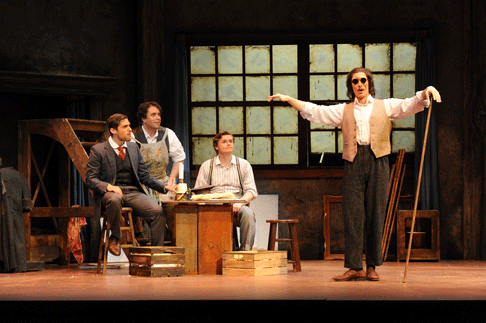 From left: Brian James Myer (Schaunard), Matthew Hanscomb (Marcello), Kirk Dougherty (Rodolfo), and Colin Ramsey (Colline)
From left: Brian James Myer (Schaunard), Matthew Hanscomb (Marcello), Kirk Dougherty (Rodolfo), and Colin Ramsey (Colline)
Baritone Matthew Hanscom has also contributed many enjoyable performances during his time with OSJ, but none have been more impressive than his beautifully rendered Marcello. Mr. Hanscom sports a big, burnished tone with plenty of buzz and sheen. As the painter, he displays a sense of arching line that is wonderfully controlled and highly satisfying. O Mimì, tu più non torni found colleagues Matt and Kirk in perfect sync, vocally and emotionally, and it was one highlight of many in the evening’s music-making.
Colin Ramsey’s participation always raises high expectations, since this talented young bass always brings assured singing and committed stage presence to every role. Mr. Ramsey does not disappoint, scoring a solid success with a wrenching, doleful Vecchia zimarra. Schaunard can sometimes blend into the garret since he has no solo or duet, but with the wiry, animated Brian James Myer in the part, there was plenty of high-viz stage business, and a richly detailed characterization. Mr. Myer deployed his well-schooled lyric baritone in excellent service to the role, singing with characterful presence.
Alone, all four of these outstanding leading men were merely ‘terrific.’ As a quartet of living, breathing, emotive, interactive playmates, they were ‘as good as it gets.’
Not that the distaff side wasn’t of a high caliber. Vanessa Becerra brought a silvery, well-projected soprano to the role of Musetta. Her appealing look and pert demeanor explored every aspect of the flirtatious coquette. And her easily produced lyricism fell agreeably on the ear. I only suggest that the talented Ms. Becerra might discover a little more genuine gravitas for the final act as she keeps exploring the role.
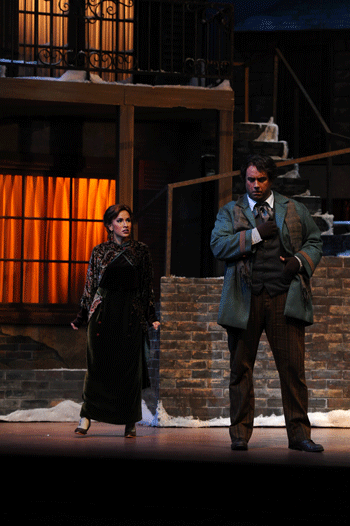 Vanessa Becerra (Musetta) and Matthew Hanscom (Marcello)
Vanessa Becerra (Musetta) and Matthew Hanscom (Marcello)
Sylvia Lee, who was such a successful Lucia earlier in the season, brought her laudable vocal gifts to the hapless Mimi. During her opening pages, she seemed a bit cautious, as if feeling her way through a role she wasn’t quite convinced was a good fit, and the parlando sections had a slight brittle quality. But once she could get above the staff, Ms. Lee’s approach loosened up, and she showed that all her limpid high notes were in fine estate, thank you very much.
As the evening progressed, her Mimi took on all of the required tragic stature, and her internalized feelings became fully realized in a characterization of tonal beauty and dramatic commitment. By opera’s end, the soprano seems to have convinced both herself and us that she is absolutely a worthy artist to portray the world famous singing seamstress.
Carl King was a relatively youthful Benoit, but his approach was appealing and infectious, and he sang the role with beauty of tone infused with humorous invention. Yungbae Yang intoned Parpignol’s lines with steady precision, and Vagarsh Martirosyan suffered amusingly as a buffo Alcindoro.
Joseph Marcheso conducted with a heady enthusiasm that was joyously urgent. With his cast and a large, responsive orchestra, he sometimes took familiar passages at a faster clip than traditional, but always to good effect. When it came to the expansive Puccini ‘money moments,’ the maestro elicited lustrous results, the kind of goose bump inducing music-making that characterizes the very best interpretations. Andrew Whitfield’s chorus sang cleanly and contributed all the gusto and atmosphere the piece requires.
The company has updated the setting to post-World War One Paris, almost always to interesting ends. Kim A. Tolman’s large-scale set design is a masterpiece of a Monmartr’ian Rubik’s Cube. It turns and repositions, and gets re-dressed and re-purposed with eye-popping results. Twice, the curtain reveal of a new setting garnered well-merited audience applause. Pamila Z. Gray’s lighting was effective in establishing indoor and outdoor locations and times of day, and her textured washes were complemented with good specials and isolated areas. The only rather abrupt cue was when the lovers’ candles went out in Act One. It suddenly got darker out of all proportion to the amount of illumination those two li’l ol’ candles could have been giving off.
The lavish, varied, masterful costume design was provided by Alina Bokovikova. The characters were greatly enhanced by her thoughtful attire, and the delineation of the denizens of the Paris street scene was an embarrassment of visual riches. Christina Martin contributed a thoughtful make-up and wig design, with a clever ‘hair’ effect. When Colline speaks in Act One of cutting his hair, he refers to his long scraggly beard. Sure enough, in Act Two, he is clean shaven. Very thoughtful detail in a production that is rife with such attention.
Michael Shell is a very gifted director who moves his cast through their story-telling with insightful precision. Whether moving crowds of people, or devising meaningful small-scale expressions of character relationships, he proves to be equally adept. One of his greatest skills is that Mr. Shell knows how to place singers in a relationship to the audience so that they are heard to maximum effect in the house. Another is that he devises blocking that unfolds with a natural simplicity and inevitability. I will never forget the moment when Mimi is on her deathbed and calls out the characters’ names one by one. They effortlessly glided into a stage picture of grieving solidarity that was so unerringly lovely that, damn if I am not tearing up again just thinking about it.
There are a few endearing oddities in this update that are mostly intriguing, or at least, not distracting. Colline has been blinded in the war, wears dark glasses, and carries a tapping cane. Schaunard is his attentive care-giver. And (spoiler alert:) ultimately revealed as somewhat more than that. The parade in Act II is a victory march imagined to be passing in the audience, with actors waving French and US flags. A banner in English seemed out of place. But even with these few well-intended ‘gilding of the lilies,’ this was a winning, thought provoking, lovingly rendered, treasurable La bohème.
Opera San Jose’s next season promises much. As this triumphant season closes with such a flourish, it will have much to live up to.
James Sohre
Cast and production information:
Rodolfo: Kirk Dougherty; Marcello: Matthew Hanscom; Colline: Colin Ramsey; Schaunard: Brian James Myer; Benoit: Carl King; Mimi: Sylvia Lee; Parpignol: Yungbae Yang; Musetta: Vanessa Becerra; Alcindoro: Vagarsh Martirosyan; Conductor: Joseph Marcheso; Director: Michael Shell; Set Design: Kim A. Tolman; Costume Design: Alina Bokovikova; Lighting Design: Pamila Z. Gray; Wig and Make-up Design: Christina Martin; Chorus Master: Andrew Whitfield
image=http://www.operatoday.com/Rodolfo-Mimi.png
image_description=Kirk Dougherty (Rodolfo) and Sylvia Lee (Mimi) [Photo by Pat Kirk]
product=yes
product_title=San Jose’s Bohemian Rhapsody
product_by=A review by James Sohre
product_id=Above: Kirk Dougherty (Rodolfo) and Sylvia Lee (Mimi)
Photos by Pat Kirk
Fine Traviata Completes SDO Season
Domingo’s costumes featured form fitting, slinky long gowns. In Act I, raven haired Violetta arrived in a town car wearing silver-tinged white. For Flora’s Act III party, Violetta wore sparkling black while Flora hosted in copper-trimmed splendor. The men sported perfectly coordinated formal wear of the era. Flora’s dancers performed in minimal metallic costumes that underscored the Egyptian lines of Kitty McNamee’s choreography.
Domingo’s scenic designs included iconic furniture for Act I, an autumn garden for Act II, a chic salon with shiny black and gold pillars holding up a balcony for Act III and a huge bed beneath a star-filled sky for the fulfillment of the tragedy in Act IV. Most of Alan Burrett’s lighting functioned well but there was a tiny light spill atop the shiny black proscenium.
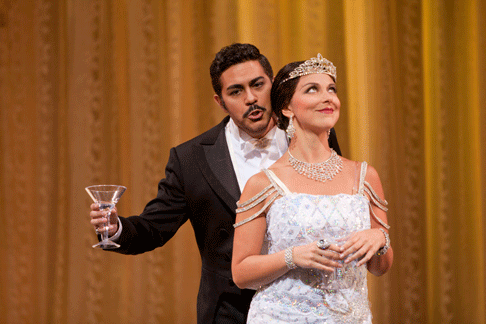 Jesús Garcia is Alfredo Germont and Corinne Winters is Violetta Valéry
Jesús Garcia is Alfredo Germont and Corinne Winters is Violetta Valéry
Conductor David Agler, the artistic director of Ireland’s Wexford Festival, kept the orchestral accompaniment in propulsive mode with pleasant, appropriate tempi. Occasionally, he made a smaller voice difficult to hear, but I enjoyed his knowledgeable approach to the score. Chorus Master Bruce Stasyna’s group moved like individual couples as they sang their secure harmonies.
The Violetta, Corinne Winters, had no trouble being heard and she gave an engrossing rendition of her role. Winters’ interpretation showed the audience both the public glamor of the celebrated nineteenth century courtesan and the private tragedy of the real woman’s illness ending in death at the age of twenty-three. Winters displayed Violetta’s longing for a normal life in “A forse lui” (“Perhaps he’s the one”) but she soon tossed that aside with wonderful coloratura runs in “Sempre Libera” (“Always Free”).
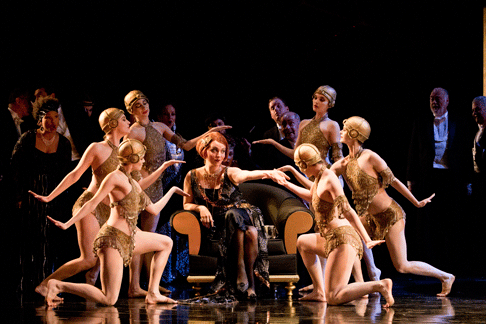 Peabody Southwell is Flora Bervoix
Peabody Southwell is Flora Bervoix
Winters’ vocal and physical acting in the ensuing acts made her Violetta truly memorable. The recipient of undeserved insults in Act III, she became a tragic heroine in Act IV as she struggled to stand and dream of a life with Alfredo. Eventually, when she sang that love and understanding had come far too late, many audience members were in tears as the opera ended.
As Alfredo, tenor Jesús Garcia sang with bronzed tones. He was a stalwart consort for Winters, although he seemed to be plagued by allergy during his second act aria. Stephen Powell sang the often-ungrateful part of Alfredo’s custom-bound father, Germont. Powell’s large, resonant voice enchanted the San Diego operagoers, and they greeted his aria “Di Provenza il mar, il suol” (“The sea, the soil of Provence”) with momentous applause.
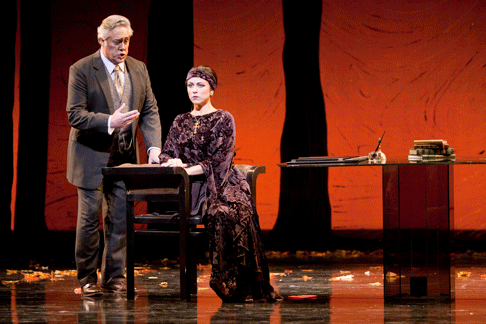 Stephen Powell is Alfredo Germont and Corinne Winters is Violetta Valéry
Stephen Powell is Alfredo Germont and Corinne Winters is Violetta Valéry
Peabody Southwell was an unusually dramatic Flora and Tasha Koontz sang beautifully as Annina. Kevin Langan’s distinctive bass sound defined the role of Dr. Grenvil, while the rich voices of Brenton Ryan, Scott Sikon, and Walter DuMelle filled out the roster of upper class partygoers. Solo Dancer Louis Williams seemed to defy gravity with his leaps, and he proved to be a skilled partner as he danced a mini pas de deux with each member of the corps de ballet.
It was a delight to again be in the Civic Theater where San Diego Opera has presented so many fine performances. Next season the company will present six shows: Gilbert and Sullivan’s The Pirates of Penzance, Puccini’s Turandot, and Catan’s Florencia in el Amazonas will be found at the Civic Theater while two chamber operas, Kaminsky’s As One and Piazzolla’s Maria de Buenos Aires, will be seen at the Joan B. Kroc and Lyceum Theaters. Finally, San Diego opera and the San Diego Symphony will get together for a concert starring René Barbera and Lise Lindstrom at Balboa Theater.
Maria Nockin
Cast and production information:
Violetta, Corinne Winters; Flora, Peabody Southwell; Der Grenvil, Kevin Langan; Gastone, Brenton Ryan; Marquis d'Obigny, Scott Sikon; Alfredo, Jesús Garcia; Baron Douphol, Walter DuMelle; Annina, Tasha Koontz; Giuseppe, Mario Rios; Giorgio Germont, Stephen Powell; Messenger, Michael Blinco; Servant, David Marshman; Conductor, David Agler; Director, Costume and Scenic Designer, Marta Domingo; Lighting Designer, Alan Burrett; Choreographer, Kitty McNamee; Wig and Makeup Designer, Stephen W. Bryant; Chorus Master, Bruce Stasyna.
image=http://www.operatoday.com/LaTraviata_041917_014.png
image_description=Corinne Winters is Violetta Valéry, flanked by the San Diego Opera Chorus [Photo by J. Katarzyna Woronowicz Johnson]
product=yes
product_title=Fine Traviata Completes San Diego Opera Season
product_by=A review by Maria Nockin
product_id=Above: Corinne Winters is Violetta Valéry, flanked by the San Diego Opera Chorus
Photos by J. Katarzyna Woronowicz Johnson
The Exterminating Angel: compulsive repetitions and re-enactments
The Exterminating Angel - a co-production with the Salzburg Festival, The Metropolitan Opera and the Royal Danish Opera - was premiered to great acclaim at the 2016 Salzburg Festival, and most of the original stellar ensemble cast reprise their roles here at Covent Garden. The libretto is the result of a long collaboration between Adès and director Tom Cairns (according to the latter, work on the text started in 2009), and is based upon Luis Buñuel’s 1962 film El ángel exterminador, in which the Mexican surrealist lampoons a bunch of egocentric aristocrats who, gathering for a lavish post-opera dinner party, find themselves afflicted by a surreal curse. Despite the open door, they are inexplicably unable to leave the elegant dining room. Even as their conditions deteriorate, and hunger and desperation bring degradation, they cannot will themselves to cross the threshold. Outside, the servants - who, blessed with a sixth sense that scented the imminent danger, fled the mansion before the guests arrived - are disinclined to rescue their social betters.
Buñuel injects the carnivalesque with a dose of Sartre and a dash of Beckett. The inexact but excessive repetitions of his film reveal the solipsism and arrogance of these vain bourgeoisie who accuse the servants of being like rats deserting a ship, blaming them for their predicament rather than acknowledging their own lack of will. The tone is abstract and absurd, and the focus is on the ensemble rather than on individual protagonists, as Buñuel exposes the sterility of the ritual-like behaviour that structures daily life and social interaction.
Adès replaces Buñuel’s cinematic wit with musical parody and ingenuity, but the musical structures, macro and micro, confirm the film’s exposure of mankind’s obligation to repeat, even while the opportunity for individual musical expression offers emotional ‘close-ups’. The clamour of church bells which accompanies the audience’s arrival in the auditorium, heralds the exterminating angel is heard again at the opera’s close. The arrival of the guests is not only staged twice - as in the film - but is also built upon a passacaglia form, as if the aristocrats are stuck on a spiralling stairway, plummeting down into the abyss. In the final Act, as the guests seat themselves around the burning brazier to devour their feast of lamb (as Bach’s ‘Sheep May Safely Graze’ insouciantly but piquantly infiltrates the score), they slip back into the obsequious small talk of their opening dinner party in a futile attempt to re-establish social equilibrium, just as the quasi-waltz of Lucia’s Act 1 ‘ragout-aria’ lurches distortedly into ear-shot.
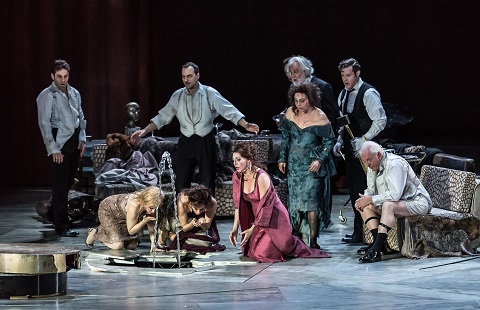 Photo credit: Clive Barda.
Photo credit: Clive Barda.
Many of the moments of musical ‘stillness’ are built upon variation forms. For example, the music of Blanca’s Act 1 aria - based on the children’s poem ‘Over the Sea’ by Chaim Bialik - takes the form of variations on the Ladino song ‘Lavaba la blanca niña’, intimating the vapid predictability of post-dinner discourse. Many of the arias make use of strophic forms, and frequent pedal points and ostinatos enhance the sense of overwhelming stasis, as such repetitive devices musically embody habitual bourgeois behaviour. Even the thundering interlude between Acts 1 and 2 - which alludes to Buñuel’s Drums of Calanda (1964) and the filmmaker’s native Calanda where, during Holy Week, the drums would resound for three days and three nights - develops from a repeating rhythmic motif.
The opera’s score is an ingenious re-enactment of the past in the present. But, in this work Adès’s characteristically and remarkably skilful parodic eclecticism does more than remind us that our experience of music is filtered through our memory of past musical experiences - from medieval song to modernism; here, such musical echoes imply own our entrapment. So, in Act II the ‘Fugue of Panic’ layers snatches of Strauss waltzes - and Adès imagines the latter as teasing and taunting, ‘Why don’t you stay a little longer? Don’t worry about what’s going on outside’ - as the artifice of which the waltz is a symbol, and upon which the guests’ sense of propriety is founded, is exposed as illusory.
There is no doubting Adès’s astonishing dexterity and perspicacity, nowhere more evident than in his inventive handling of the large orchestral forces, comprising piano, guitar and a whole arsenal of percussion. But, Buñuel’s black humour seems diluted; the ‘laughs’ - judging from the audience reaction at this performance - are primarily derived from recognition of musical echoes, which ironically makes Buñuel’s point.
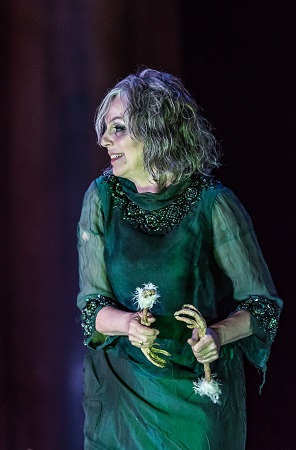 Anne Sofie von Otter. Photo credit: Clive Barda.
Anne Sofie von Otter. Photo credit: Clive Barda.
Buñuel, irritated by attempts to psychologically ‘un-pick’ his film, retaliated, “I simply see a group of people who couldn’t do what they wanted to - leave a room”. (Luis Buñuel, My Last Breath, trans. Abigail Israel, 1984). Adès’s exterminating angel takes more tangible form. It is a supernatural or mythical force which takes possession of the guests and leads to what the composer describes as ‘an absence of will, of purpose, of action’. Musically, the angel is embodied by the nightmarish wail of the ondes martenot - the first time that Adès has used an electronic instrument in his music. At moments when the characters find themselves unable to act, or when they die, the return of this alien timbre reinforces their entrapment; it is a ‘voice’ that Adès describes as treacherously attractive and alluring, “like the sirens of Greek mythology, saying: ‘Stay!’”
Tom Cairns directs the large cast with meticulous attention to detail while Hildegard Bechtler’s set is sensibly sparse, dominated by an imposing, square proscenium which swivels like a Kafkaesque plot, denying the characters escape until the closing moments.
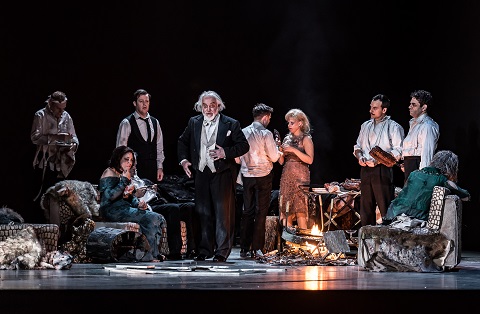 John Tomlinson (centre). Photo credit: Clive Barda.
John Tomlinson (centre). Photo credit: Clive Barda.
The cast list reads like a family-tree of British singing-aristocracy, with John Tomlinson and Thomas Allen relishing their character roles as fusty doctor and lusty conductor respectively, while Christine Rice sings beautifully as the latter’s wife, Blanca, and Sally Matthews wins our sympathy as the bereaved Silvia de Ávila who in Act III pitifully cradles a dead sheep in her arms believing that her ‘Berceuse macabre’ is a lullaby for her son Yoli. Anne Sofie von Otter is brilliantly baffled as the old battle-axe, Leonora Palma, slipping painfully from reality in her Act 3 aria, a number which sets Buñuel’s 1927 poem ‘It Seems to Me Neither Good Nor Evil’ - a textual strategy that Cairns and Adès employ in several of the ‘aria moments’ to convey the characters’ mental states.
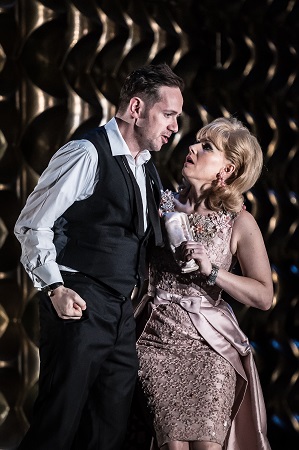 Iestyn Davies and Sally Matthews. Photo credit: Clive Barda.
Iestyn Davies and Sally Matthews. Photo credit: Clive Barda.
In a parodic Baroque mad aria, Iestyn Davies (as Francisco) becomes wonderfully and woefully unhinged when he finds that there are no coffee spoons with which to stir his post-dinner beverage, and his sister-fixation with Matthews’ Silvia is convincingly conveyed - well as ‘convincing’ as surrealism can be. Sophie Bevan and Ed Lyon are a touching pair of lovers, Beatriz and Eduardo, remaining apart from the bourgeois vacuities and choosing to commit suicide, in the score’s most delicate duet - a veritable Liebestod, sung from within a suffocating closet - rather than to become victims of the exterminating angel.
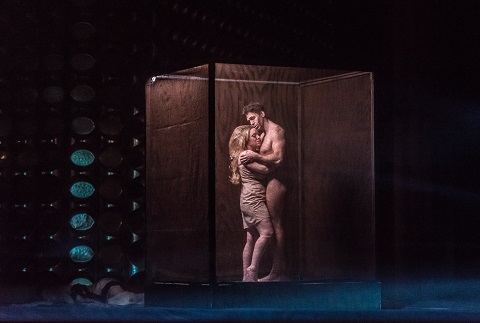 Sophie Bevan and Ed Lyon. Photo credit: Clive Barda.
Sophie Bevan and Ed Lyon. Photo credit: Clive Barda.
Though I couldn’t hear a word she sang, Amanda Echalaz is a luscious-toned hostess, Lucia Marquesa de Nobile, and if Charles Workman, as her husband, scales the tenorial heights with aplomb, then Audrey Luna tops him, literally and figuratively, as Leticia Maynar - the opera singer whose performance in Lucia di Lammermoor ostensibly prompts the original gathering. Luna’s stratospheric peels are as ‘unreal’ as the ondes martenot’s eerie howl and perhaps it is no coincidence that Leticia, the so-called ‘Valkyrie’, who does not share the aristocratic pretensions of the other diners, is aligned with the otherness of the exterminating angel; for it is Leticia who first recognises their entrapment and it is she, at the close, who, with her strange quasi-medieval chanson, enables their ‘release’.
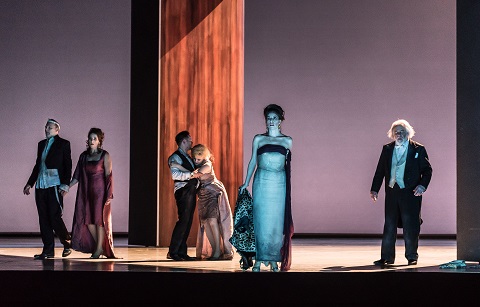 Audrey Luna. Photo credit: Clive Barda.
Audrey Luna. Photo credit: Clive Barda.
At the end of El ángel exterminador, the characters are ‘freed’ by the re-enactment of the patterns of their imprisonment. The survivors go to the cathedral to mourn those who have been lost and give thanks for their own assumed emancipation, but as they seek solace in the passive church rituals they find themselves entrapped once more, the cathedral doors locked.
Adès and Cairns offer a different conclusion. The Chorus sing a line from the Requiem mass over and over in a chaconne that, it seems, could go on for ever. The score has no double-bar line to signal its close. The music simply stops in the present, presumably to continue for eternity. And, so, the opera is itself a ‘repetition’, or a ‘repetition with difference’, reprising Buñuel’s film and creating a discursive space between the media of film and opera.
Buñuel sometimes showed contempt for those who tried to pin down the ‘meaning’ of his films. A caption at the start of El ángel exterminador reads, ‘The best explanation of this film is that, from the standpoint of pure reason, there is no explanation’ and the film-maker declared, “This rage to understand, to fill in the blanks, only makes life more banal. If only we could find the courage to leave our destiny to chance, to accept the fundamental mystery of our lives, then we might be closer to the sort of happiness that comes with innocence”. ( My Last Sigh)
But, it is difficult to ignore the search for ‘meaning’. One might look to Buñuel’s own time: are the film’s aristocrats, marooned in their elitism while the populace protest outside, a metaphor for Franco’s Spanish regime, from which Buñuel was in exile in Mexico when he made the film? Is the film a nihilistic statement by one who had witnessed the catastrophes of the Spanish Civil War?
At the ‘close’ of Adès’s opera I found myself wondering to what extent he was playing musical games and how far he was - hilariously and terrifyingly - satirising our own lives.
Claire Seymour
Thomas Adès: The Exterminating Angel
Libretto: Tom Cairns, after Luis Buñuel and Luis Alcoriza
Leonora - Anne Sofie von Otter, Blanca - Christine Rice, Nobile - Charles Workman, Lucia - Amanda Echalaz, Raúl - Frédéric Antoun, Doctor - John Tomlinson, Roc - Thomas Allen, Francisco - Iestyn Davies, Eduardo - Ed Lyon, Leticia - Audrey Luna, Silvia - Sally Matthews, Beatriz - Sophie Bevan, Lucas - Hubert Francis, Enrique - Thomas Atkins, Señor Russell - Sten Byriel, Colonel - David Adam Moore, Julio - Morgan Moody, Pablo - James Cleverton, Meni - Elizabeth Atherton, Camila - Anne Marie Gibbons, Padre Sansón - Wyn Pencarreg, Yoli - Jai Sai Mehta; Director - Tom Cairns, Conductor - Thomas Adès, Set and costume designer - Hildegard Bechtler, Lighting designer - Jon Clark, Video designer - Tal Yarden, Choreographer - Amir Hosseinpour, Orchestra of the Royal Opera House (ondes martenot - Cynthia Millar, piano - Finnegan Downie Dear), Royal Opera Chorus (Chorus director - William Spaulding).
Royal Opera House, Covent Garden, London; Monday 24th April 2017.
image=http://www.operatoday.com/170421_0813%20angel%20adj%20EXTERMINATING%20ANGEL%20PRODUCTION%20IMAGE%20%28C%29%20ROH.%20PHOTO%20BY%20CLIVE%20BARDA.jpg image_description=The Exterminating Angel, Royal Opera House product=yes product_title=The Exterminating Angel, Royal Opera House product_by=A review by Claire Seymour product_id=Above: The Exterminating AngelPhoto credit: Clive Barda
April 24, 2017
Dutch National Opera revives deliciously dark satire A Dog’s Heart
Soviet censorship nixed the publication of Mikhail Bulgakov's 1925 satirical novella, Heart of a Dog, on which Cesare Mazzonis based his libretto. Its plot, in which an eminent professor transplants a man’s pituitary gland and testicles into a scraggy stray dog, is an allegory of the foisting of Communist ideology on Russian society. Professor Preobrazhensky (his name is related to the word “transformation”) wants to rejuvenate the dog, Sharik. But instead of just perking up, Sharik starts becoming human, eventually transforming into Sharikov. This rude, lascivious menace turns the professor, his assistant Dr. Bormenthal, and their servants into nervous wrecks. Further galling the professor's life is Shvonder, his apartment building’s Head of the Residents’ Committee. He tries to shrink the professor's living space and gives Sharikov a job ridding the city of stray cats. When Sharikov's lying, befouling and sexual incontinence get out of control, the professor reverses the transplant, turning him back into an agreeable dog.
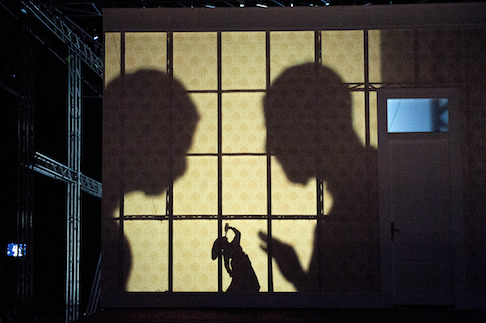 Scene from A Dog’s Heart
Scene from A Dog’s Heart
McBurney's staging, revived under Josie Baxter’s supervision, visually realizes the great divide between the professor, ensconced in his gold-and-white rooms, and the grey-clad proletarian masses he despises. Preobrazhensky, who dresses for dinner and enjoys fine wine and Italian opera, has to endure Shvonder and his workers droning Soviet hymns. By means of an enormous wall that slides backwards and forwards, the action moves from room to room or out onto the snowy streets. The wall also serves as a screen for projecting footage in 1920s Russian style. Every aspect of this darkly hilarious production, from prop to personage, is purposefully choreographed. It is difficult to decide which performance is more fascinating: Sharik the puppet dog and his four handlers using bunraku, a Japanese puppetry technique, or tenor Peter Hoare as the unmistakably canine Sharikov. Although the handlers are visible all the time, Sharik slinks, leaps and drools so naturally, that one forgets all about them. Hoare is so uninhibitedly feral that when Bormenthal wants to kill him, the audience sympathizes.
The cast, led by a commanding Sergei Leiferkus as the professor, is uniformly convincing. Baritone Ville Rusanen was a vocally excellent Bormenthal and bass Gennady Bezzubenkov a hair-raisingly sinister, string-pulling Big Boss. Only Hoare and the dog, however, could compete with the brilliant stage business. Some of the briefest scenes are the best, such as a dream sequence in which Sharikov embarrasses Preobrazhensky in front of his colleagues with a lewd song. The two operations also stand out — one comical, using shadow theatre, the second alarmingly gory. Besides moving like clockwork, the staging is deliciously illustrative, with cats swinging from the chandelier (more puppet wizardry) and pink monkey ovaries bobbing in green fluid.
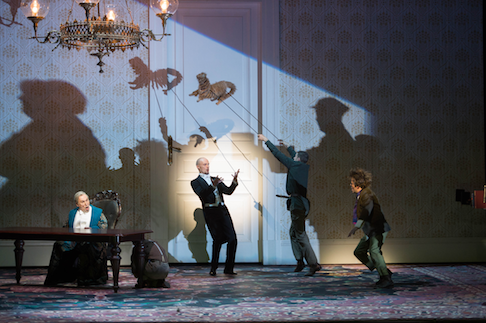 Filipp Filippovitsj (Sergei Leiferkus), Poppenspelers, Bormenthal (Ville Rusanen) and Sjarikov (Peter Hoare)
Filipp Filippovitsj (Sergei Leiferkus), Poppenspelers, Bormenthal (Ville Rusanen) and Sjarikov (Peter Hoare)
Raskatov's angular score bravely extends the satirical operatic legacy of Dmitri Shostakovich (The Nose) and Alfred Schnittke ( Life with an Idiot), applying the same polystylistic idiom. However, unlike the staging, the score does not have a clear narrative. It supports and punctuates, rather than recounts. Raskatov creates a myriad sound effects and impressions by supplementing the traditional orchestra with, among others, a saxophone family, a balalaika, an electric guitar, a harpsichord and percussion galore. The Netherlands Chamber Orchestra under Martyn Brabbins adeptly evoked the plentiful flavors, which, alas, do not amount to an intriguing three-course dinner. The score’s strongest point is that it assigns each character a recognizable vocal style. Sharik has two voices, sometimes singing together: Nasty Sharik, soprano Elena Vassilieva growling into a megaphone, and Nice Sharik, plaintive countertenor Andrew Watts. Like his predecessors, Raskatov follows Russian speech rhythms, but his vocal means are limited in variation.
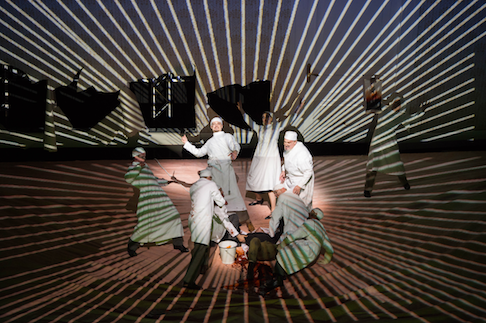 Filipp Filippovitsj (Sergei Leiferkus) & Bormenthal (Ville Rusanen) and Sjarikov (Peter Hoare)
Filipp Filippovitsj (Sergei Leiferkus) & Bormenthal (Ville Rusanen) and Sjarikov (Peter Hoare)
After a while, three main styles emerge. The men either huff in staccato syllables or repeat legato phrases in short ariosos, while the women shriek out notes with agonizing intervals. Alexey Sulimov whined efficaciously as killjoy Comrade Shvonder. Elena Vassilieva, Nasty Sharik, doubled as Darya the cook, who mostly reached for top notes or fished for bottom ones. As the excitable maid Zina, Nancy Allen Lundy’s chief task was to squeal out improbably high notes. Sharikov’s fiancée, soprano Sophie Desmars, suffered in jagged coloratura, then sang some warming-up vocal exercises. Raskatov's intentions and orchestral colors are thought through, and it is a shame that his score is not more distinguished. Some excerpts, such as the screaming duet between Darya and Zina, are so heavy-handed as to miss their caricatural point entirely. The music works best when decorating speech or escalating tension with whiplashing dissonant chords. If one doesn’t think of A Dog's Heart as an opera, the score is a highly effective soundtrack for a singular, special piece of theatre.
Jenny Camilleri
Cast and production information:
Professor Filipp Filippovich Preobrazhensky: Sergei Leiferkus; Ivan Arnoldovich Bormenthal: Ville Rusanen; Poligraf Poligrafovich Sharikov: Peter Hoare; Darya Petrovna/Voice of Nasty Sharik: Elena Vassilieva; Zina: Nancy Allen Lundy; Shvonder: Alexey Sulimov; Vyasemskaya/Voice of Nice Sharik: Andrew Watts; Big Boss/Fyodor/Paperboy: Gennady Bezzubenkov; Sharikov’s Fiancée: Sophie Desmars; First Patient/Provocateur: Alasdair Elliot; Second Patient: Annett Andriesen; Proletarians: Sophie Desmars, Andrew Watts, Alexey Sulimov, Piotr Micinski; Detective: Piotr Micinski. Director & Choreographer: Simon McBurney (revival supervised by Josie Baxter); Set Design: Michael Levine; Costume Design: Christina Cunningham; Lighting Design: Paul Anderson; Video: Finn Ross; Puppetry: Blind Summit Theatre (Mark Down, Nick Barnes); Movement: Toby Sedgwick. Conductor: Martyn Brabbins. Dutch National Opera Chorus, Netherlands Chamber Orchestra. Seen at Dutch National Opera, Amsterdam, on Saturday, 22 nd April 2017.
image=http://www.operatoday.com/a_dogs_heart_17_306.png image_description=Sjarikov (Peter Hoare) [Photo by Monika Rittershaus] product=yes product_title=Dutch National Opera revives deliciously dark satire A Dog’s Heart product_by=A review by Jenny Camilleri product_id=Above: Sjarikov (Peter Hoare)Photos by Monika Rittershaus
April 22, 2017
A Chat With Italian Conductor Riccardo Frizza
He also tells us why some of Donizetti's masterworks are better known than others, although a number of his lesser known works are of equal merit.
Q: Where did you grow up?
RF: I was born in Brescia, in the Lombard region of Italy, and grew up in a countryside village about ten kilometers from the city. Although I wouldn’t call my family musical, I started piano lessons when I was five years old after playing a small toy, one that my parents had bought me for Christmas. After high school, I studied at the Giuseppe Verdi Conservatory in Milan and at the Accademia Chigiana in Siena. Later, I did graduate work in harmony, counterpoint and fugue in Milan, and conducting in Siena.
Q: Are there any artists or musicians from the past whose work has significantly influenced you?
RF: When I discovered the orchestra as an instrument, I was totally mesmerized and in love with Leonard Bernstein. Several masters of the Italian school, including Claudio Abbado and Riccardo Muti, subsequently influenced me. My most significant teachers were: composer Elisabetta Brusa, who taught me to be able to understand music, and conductor Gilberto Serembe, who taught me the basics and the necessities of conducting technique. Perhaps the most important thing I learned from them is that conducting is not just getting the orchestra to play together. It is the conductor’s responsibility to have musical ideas to present to the musicians, as well as to the listener. If you don’t have anything inside of yourself to express, nothing will pour forth from your conducting.
Q: What did you learn from your teachers that you especially want to pass on to the instrumentalists and singers with whom you work?
RF: Often, young conductors are afraid to be clear in conducting or are only focused on the beauty of the gesture. Thus, they forget the reason why they are on the podium: the music.
Q: Do you ever teach?
RF: I don’t teach anywhere on a regular basis because my activity as a performer doesn’t allow me to have a permanent position. It is also something I don’t want to do, at least at this point of my career. Perhaps I’ll change my mind in the future. I have to say that I love teaching conducting and I teach whenever my calendar gives me the time needed. Actually one of my ‘fellows’ was the recipient of the first prize at the Tokyo International Conducting Competition in 2015.
Q: What level of musicianship do you see in young American singers?
RF: Their level of musicianship is very high! You have such great universities, and the best music schools on the globe. Also, now it is much easier for the students to get information and knowledge. They can also travel to take master classes with the most important figures of the opera world. I think anyone with talent can emerge into the profession. Obviously, if you have a good income you can study in the best academies, but there are many public institutions where you can attend classes with superb teachers. There are examples of great artists, “stars,” such as Juan Diego Florez, Pretty Yende, and Lawrence Brownlee who advanced and became famous even though they did not have easy economic conditions.
Q: Please tell us something about your forthcoming performances:
RF: I love Chicago. I made my Lyric Opera debut in Kevin Newbury’s production of Vincenzo Bellini’s Norma and it was a memorable experience for me to be at this major music center. Lyric’s Norma was a co-production between Lyric, the Canadian Opera Company, the San Francisco Opera, and the Liceu in Barcelona. Norma is Bellini’s greatest opera and it is best known for the purity of the singing it requires.
I am conducting Rigoletto in Spain and it is one of my favorite scores. I call it Verdi’s perfect opera. It was the very first of the masterful operas Verdi composed. Dutch director Monique Wagemakers will stage Rigoletto at the Gran Teatre del Liceu of Barcelona. She did a wonderful job when she staged the same opera in Madrid a few years ago. Her production was minimal and had a modern set but her direction followed Verdi’s wishes exactly. Thoroughly introspective, this production permits all the psychological aspects of the characters to come through.
Q: Of equally great masterworks, why do you think some are better known than others?
RF: I think the fortune of some operas is related to the fame of the artists who interpret them. This is also one of the reasons why some titles are not famous. Try to think what Norma would be without Callas or Attila without Ramey. Those operas were not famous until opera companies staged them with stars in their leading roles. I hope to convince some modern stars to do more unusual repertoire.
Gaetano Donizetti’s works are not well enough understood. As an interpreter, I would like to present more of the rare titles of his catalogue. He is a genius too often forgotten and there is so much yet to be discovered. In the last two or three decades we have become familiar with some of Donizetti’s operas, particularly La Favorita and the Tudor trilogy: Anna Bolena, Maria Stuarda, and Roberto Devereux. However, I consider operas such as Maria di Rohan, Maria de Rudenz, Poliuto, and Dom Sebastien to be equally valuable masterpieces and they are not staged at all. In the future, I certainly hope major opera houses will stage them.
I have a special relationship with Venice’s Teatro La Fenice where I will be conducting Lucia di Lammermoor. The city of Venice is magical and the Fenice or Phoenix is one of the most beautiful opera houses in the world. The fact that there are no cars in the city and that people have to walk over the bridges and through the narrow streets makes the ambience more relaxed. One begins to understand how much less frenetic life was two centuries ago.
Francesco Micheli, who will stage a new production of Lucia at the Fenice, is one of the most interesting Italian directors of the new generation. Despite his youth, he is the artistic director of the Donizetti Festival in Bergamo. Francesco knows the Donizetti world very well and I’m really looking forward to working on this masterpiece beside him. The second reason I’m looking forward to Lucia is that Nadine Sierra will sing the title role. In my opinion, she is one of the most interesting sopranos of her generation.
During this summer, I will be at the Macerata Opera Festival in Italy conducting Aida. My last performances of Aida were in Seattle in 2010. I can’t wait to do this opera again because, after seven years, I can really prepare the score ex-novo. I consider myself a better musician than I was seven years ago. At least I have more experience and I have led many of Verdi’s operas in the meantime. The Arena Sferisterio in Macerata is a unique space unlike any other auditorium in the world. Seating over three thousand people, it is an open-air theater with a specific shape that provides a perfect acoustic.
About Aida, you should know that an overture exists. Verdi prepared it for the first night at La Scala, but withdrew it after a private performance that Franco Faccio conducted shortly before the Italian premiere.
Q: Who are some of the most valued singers of the past and why are their interpretations important?
RF: There are so many major figures who made the history of opera that I will limit my comments to just four: Callas, Pavarotti, Domingo, Sutherland. Each is an icon and we remember each for something special. Callas is considered to be the first modern singer because she was not only the greatest in vocal matters but she achieved the heights in acting. Her Norma is still thought to be without peer. Pavarotti is important because he was the master of the Italian school, which, unfortunately, is disappearing.
Placido Domingo has been the supreme Otello in my opinion. The way he went deeply into the interpretation both musically and dramatically is simply stunning. Dame Joan Sutherland was the first of her era to rediscover the bel canto repertoire, including the works of Donizetti, which I feel have been neglected.
Q: What recordings do you have out currently?
RF: I have so many. ITunes recently released Puccini’s La bohème, which we taped live at the Met two years ago with Kristine Opolais and Jean-Francois Borras.
Here’s an anecdote from my first studio recording. In Milan in 2003, we made Don Pasquale, which was Juan Diego Florez’s first bel canto recording. As you might know, this opera has a big introduction with a tremendously difficult trumpet solo. The producer told us to do an orchestra reading and prepare it for the take. We played it, and afterward, when I said we were ready to tape it, he answered they had gotten it already! They recorded the rehearsal and it was perfect. Very smart action: he removed the tension and the pressure of the difficult solo from the trumpet player.
Q: What do you see yourself doing five years from now?
RF: Exactly what I’m doing right now. I expect to be making music, traveling around the world and maybe starting to add some Wagner to my repertoire. It is time to discover scores such as Lohengrin and Die Meistersinger.
Q: Do you have any interesting hobbies like cooking, painting, or reading in three alphabets?
RF: I love cooking. It is my passion. My favorite is creating various types of risotto. I also like to discover the local cuisine of the countries where I’m working.
Q: Do you ever have time for a private life?
RF: I’m married to Spanish soprano Davinia Rodriguez and we have a five-year-old daughter. Since my wife is an opera singer, we are very often apart and it does not make our life easy. Sometimes it happens that we don’t see each other for more than two months. Doing the same job, however, gives us both an understanding of this lifestyle. We met during a production of L’elisir d’amore in 2005 and we have been a family since then. She’s a great artist and after her pregnancy her voice grew tremendously. She had to change the repertoire moving from coloratura to full lirico spinto. Recently, she had a huge success singing her first Lady Macbeth alongside Placido Domingo in a new production at Vienna's Theater an der Wien.
Sofia, our daughter, went to the opera for the first time when she was seven months old. In 2012, she attended the final dress rehearsal of L’elisir d’amore in Dresden at the Semperoper, but we had to take her out during the finale because she began to sing. She loves opera and she’s actually able to sing many arias.
I do suggest that kids be introduced to classical music even before they are born. During their pregnancies mothers should listen to classical music. It is very helpful for babies because they later recognize the music listened to in utero. We have had this experience with our daughter. For children, classical music should be as available as the food they eat, the toys they play with, and their mother’s smell. Then they will grow up with it as a part of their daily lives.
image=http://www.operatoday.com/Frizza_Riccardo_JHenry%20Fair.png
image_description=Riccardo Frizza [Photo by J Henry Fair]
product=yes
product_title=A Chat With Italian Conductor Riccardo Frizza
product_by=An interview by Maria Nockin
product_id=Above: Riccardo Frizza [Photo by J Henry Fair]
Opera Rara: new recording of Bellini's Adelson e Salvini
Adelson e Salvini was the 24-year-old Bellini’s ‘graduation piece’, written in 1825 for the Real Collegio di Musica di San Sebastiano in Naples. Either the student singers at Bellini’s disposal were remarkably talented, or the young composer was intent on showing off his own prowess and the singers could do or die!
My review of Opera Rara’s concert performance contained a fairly lengthy account of the work’s origins, fortunes and revisions, as well as the literary source and plot. So, suffice it to say here that Andrea Leone Tottola’s libretto, set in seventeenth-century Ireland, unfolds as a somewhat disjointed series of scenes of melodramatic scuffles, infernos and emotional volte faces, in which Lord Adelson and the Italian painter Salvini are rivals for the heart of Nelly, the niece of the vengeful Colonel Struley. There is melodrama and incredulity aplenty: in a struggle to prevent Nelly being abducted by her uncle, Salvini fears he has killed his beloved and threatens to commit suicide; but, learning she is alive - and after several fake letters have add further convolution - Adelson ultimately marries Nelly, as Salvini renounces his love and promises to return after a year to claim his young pupil Fanny as his bride.
There is little of the prototype Sonnambula-limpidity evident in the student Bellini’s nascent musical arsenal, but Rossini’s fingerprints make a deep imprint, most impressionably in the music written for Salvini’s comic servant, Bonifacio, who makes his entrance with a Rossini patter aria - accompanied by a nonchalant flute which makes a paradoxically insouciant foil for the Figaro-esque bluster of the aggrieved, put-upon Bonifacio. Bass-baritone Maurizio Muraro makes much of the text and a strong musical personality emerges, but occasionally the pitch strays from dead-centre.
Muraro himself makes a good counterpart for Enea Scala’s over-wrought and initially vocally tense Salvini; as the latter begs ‘beguiling hope’ to abandon his heart, it’s hard to disagree with his servant’s conclusion that his master is ‘really off his head’ and ‘belongs in the madhouse’. Perhaps Salvini’s vapidity and vulnerability are the inevitable outcome of the ‘insane’ cabaletta which Bellini gives the tenor, before he’s had time to warm up his vocal cords, comprising twenty-six high Cs, four Ds, and a top E. The stratospheric ascents have more elegance than Scala can muster, but it’s understandable and forgivable that he sounds strained at times, and once he’s hit the targets, Scala reveals a polished technique and pleasing tone. His would-be grave-bound avowal of love for Nelly is heartbreakingly sincere, and is complemented by the poignancy of the oboe’s lyrical commentary and the urgency of the Opera Rara Chorus (directed by Eamonn Dougan).
Salvini’s Act 2 duet, ‘Torna, o caro, a questo seno', with Simone Alberghini’s patrician-toned Adelson is beautifully enriched by some lovely horn and woodwind playing while Scala’s more relaxed tenor whips slickly but ardently through the cascades of split loyalties; both singers exhibit tenderness in the passages in seductive thirds and sixths, forming a gentle blend. This number throbs with emotions unspoken, misinterpreted and misunderstood. And, if elsewhere Alberghini doesn’t consistently display the technical assurance, accuracy and nimbleness of his colleagues, his is a convincing contribution to the drama.
The opera was performed originally by an all-male cast, even though there are three female roles, and one wonders who sang Nelly’s romanza ‘Dopo l'oscuro nembo’ (later reshaped into Giulietta’s ‘Oh quante volte’ in I Capuleti e iMontecchi), and how. For, the melodic voluptuousness of this number is a beguiling intimation of where the ‘Swan of Catania’ was heading. The pathetic instrumental prelude passes slithering motifs from the depths of the bass to the heights of the woodwind, before pizzicato strings hook the sentiment and lead into the aria proper. Perhaps bel canto patterns inevitably lead one to make connections, but there seem to me to be more than a few foreshadowings - in the harmonic progressions and melodic sighs - of ‘Una furtiva lagrima’. Daniela Barcellona is able to hold back the full power of her mezzo, prioritising elegant elaboration over vocal emoting, while using her rich tone to convey Nelly’s romantic agonies.
David Soar’s Geronio impressed me at the Barbican Hall and continues to do so on this recording: he offers dark colour to the lighter toned Colonel Struley of Russian baritone Rodion Pogossov - who still brings some heft to the role - and the duet with which the dishonourable duo open Act 2 is engagingly characterised, with some strong string pizzicato adding extra parodic fierceness and bite. Mezzo-sopranos Kathryn Rudge (Fanny) and Leah-Marian Jones (Madam Rivers) complete the accomplished cast. The recitative is well-delivered, and given that most of the cast are native Italians, dialogue director Daniel Dooner must have had a fairly easy task.
Daniele Rustioni shows off his bel canto credentials, conducting with unflagging alertness to every dramatic and lyrical detail. The Sinfonia is typical: a weighty orchestral sound, supported by a strong bass, from which, by turns, punchy and poignant woodwind themes and, here, a cello solo emerge with clarity: somehow Rustioni combines power and translucence. We can hear Bellini’s drama, restlessness and redolent emotion. If occasionally a withdrawal of the sound seems to owe more to the engineers than to Rustioni’s interpretative dynamics, this is a very minor quibble.
The glossy accompanying booklet contains a detailed and informative essay, ‘Bellini’s Full Opera’, by Benjamin Walton; an account by co-editor Fabrizio Della Setta of the new critical edition which was prepared for this Opera Rara performance and recording; a synopsis in English, French, German and Italian; and, a full Italian libretto with English translation, the spoken text usefully differentiated by coloured ink.
This is another welcome Opera Rara addition to the forgotten repertory of the nineteenth century, and the company’s forthcoming plans are exciting.
Claire Seymour
Vincenzo Bellini: Adelson e Salvini, opera in 3 acts (1825)
Opera Rara
ORC56 [CD: 73:11; 79:52]
Lord Adelson - Simone Alberghini; Nelly - Daniela Barcellona, Salvini - Enea Scala, Bonifacio - Maurizio Muraro, Colonel Struley - Rodion Pogossov, Geronio - David Soar, Madama Rivers - Leah-Marian Jones, Fanny - Kathryn Rudge; conductor - Daniele Rustioni, BBC Symphony Orchestra, Opera Rara Chorus (chorus director - Eamonn Dougan)
Recorded in May 2016, BBC Maida Vale Studios, London.
April 20, 2017
Jonas Kaufmann : Mahler Das Lied von der Erde
A single voice in a song symphony created for two voices? Not many artists have the vocal range and heft to sustain 45 minutes at this intensity but Kaufmann achieves a feat that would defy many others. Das Lied von der Erde for one soloist is a remarkable experiment that's probably a one-off, but that alone is reason enough to pay proper attention.
The dichotomy between male and female runs like a powerful undercurrent through most of Mahler's work. It's symbolic. The "Ewig-wiebliche", the Eternal Feminine, represents abstract concepts like creativity, redemption and transcendence, fundamentals of Mahler's artistic metaphysics. Ignore it at the risk of denaturing Mahler! But there can be other ways of creating duality, not tied to gender. Witness the tenor/baritone versions, contrasting singers of the calibre of Schreier and Fischer-Dieskau. For Das Lied von der Erde, Mahler specified tenor and alto/mezzo, the female voice supplying richness and depth in contrast to the anguish of the tenor, terrified of impending death. This is significant, since most of Mahler's song cycles and songs for male voices are written for medium to low voices, and favour baritones. Tenors generally get short-changed, so this is an opportunity to hear how tenors can make the most of Mahler. .
Kaufmann is a Siegmund, not a Siegfried: his timbre has baritonal colourings not all can quite match. Transposing the mezzo songs causes him no great strain. His "Abschied" is finely balanced and expressive, good enough to be heard alone, on its own terms. What this single voice Das Lied sacrifices in dynamic contrast, it compensates by presenting Das Lied von der Erde as a seamless internal monologue. Though Mahler uses two voices, the protagonist is an individual undergoing transformation: Mahler himself, or the listener, always learning more, through each symphony. Thus the idea of a single-voice Das Lied is perfectly valid, emotionally more realistic than tenor/baritone. All-male versions work when both singers are very good, but a single-voice version requires exceptional ability. Quite probably, Kaufmann is the only tenor who could carry off a single-voice Das Lied.
With his background, Kaufmann knows how to create personality without being theatrical, an important distinction, since Das Lied von der Erde is not opera, with defined "roles", but a more personal expression of the human condition. This Das Trinklied vom Jammer der Erde is unusually intense, since the person involved emphatically does not want to die. The horns call, the orchestra soars, but Kaufmann's defiance rings with a ferocity most tenors might not dare risk. Wunderlich couldn't test this song to the limits the way Kaufmann does. Schreier, on the other hand, infused it with similar courage, outshining the mezzo and orchestra in his recording with Kurt Sanderling. This heroic, outraged defiance is of the essence, for the protagonist is facing nothing less than annihilation. Twenty years ago, when Kaufmann sang Das Lied with Alice Coote in Edinburgh, I hated the way he did this song, as if it was a drinking song. Now Kaufmann has its true measure, spitting out the words fearlessly, taking risks without compromise. No trace whatsoever of Mario Lanza! This reveals a side of Kaufmann which the marketing men pushing commercial product like the Puccini compilation will not understand, but enhances my respect for Kaufmann's integrity as a true artist.
After the outburst of "Das Trinklied", "Der Einsame im Herbst" is reflective, with Kaufmann's characteristic "smoky" timbre evoking a sense of autumnal melancholy. This is usually a mezzo song, so at a few points the highest notes aren't as pure as they might be, though that adds to the sense of vulnerability which makes this song so moving. "Von der Jugen" is a tenor song, though no surprises there. If Kaufmann's voice isn't as beautiful as it often is, he uses it intelligently. The arch of the bridge mirrored in the water is an image of reversal. Nothing remains as it was. In "Von der Schönheit" Mahler undercuts the image of maidens with energetic, fast-flowing figures in the orchestra. This song isn't "feminine". The protagonist is no longer one of the young bucks with prancing horses. He has other, more pressing things on his mind. "Der Trunkene im Frühling" usually marks the exit of the tenor, recapitulating "Das Trinklied vom Jammer der Erde". Though there are tender moments, such as the bird song and its melody, the mood is still not resigned. Kaufmann throws lines forcefully : "Der Lenz ist da!", "Am schrwarzen Firmament!" and, defiant to the end with "Laßt mich betrunken sein!"
Jonathan Nott conducts the Wiener Philharmoniker. creating an atmospheric "Abschied" with muffled tam tam, woodwinds, strings, harps, celeste and mandolin. Excellent playing, as you'd expect from this orchestra. Just as the first five songs form a mini-cycle, the "Abschied" itself unfolds in several stages, each transition marked by an orchestral interlude. The dichotomy now is not merely between voice types but between voice and orchestra: altogether more abstract and elevated. This final song is the real test of this Das Lied and Kaufmann carries it off very well. Now the tone grows ever firmer and more confident. There are mini-transitions even within single lines of text, such as the beautifully articulated "Er sprach....., seine Stimme war umflort...... Du, mein Freund". At last, resolution is reached. The ending is transcendant, textures sublimated and luminous. The protagonist has reached a new plane of consciousness not of this world. Kaufmann's voice takes on richness and serenity. He breathes into the words "Ewig....ewig" so the sound seems almost to glow. Utterly convincing. This isn't the prettiest Das Lied von der Erde on the market, but it wouldn't be proper Mahler if it were. It is much more important that it is psychologically coherent and musically valid. Too often, interesting performances are dismissed out of hand because they are different, but Kaufmann's Das Lied von der Erde definitely repays thoughtful listening.
Anne Ozorio
image=https://cdn.smehost.net/sonymusicmasterworkscom-45pressprod/wp-content/uploads/2016/06/613DMKJxRL._SS500.jpg
product=yes
product_title=Gustav Mahler : Das Lied von der Erde- Jonas Kaufmann, Weiner Philharmoniker, Jonathan Nott (conductor), Sony Classics
product_by=A review by Anne Ozorio
product_id=
Garsington Opera For All
SCREENINGS ON BEACHES, RIVER BANKS AND PARKS
In each location a large-scale programme of education and outreach work is firmly integrated with the free public screenings and will provide ground-breaking opportunities for communities to be involved in creating, learning about, and performing opera. Semele will also have a free public screening as part of Oxford Festival of the Arts (1 July) and Garsington Opera's 2016 production of Tchaikovsky’sEugene Onegin will be screened this year at the Buckingham Film Place community cinema (17 June).
Opera for All is a programme which challenges expectation by uncovering the ingredients and foundation of opera - drama, music, story-telling and expressive emotion. In 2016 Opera for All worked with 25 schools, reached 1,000 young people, working directly with artists in residencies, and provided skills development for 50 teachers. Over 2,500 people attended the opera screenings. For the students in each location, the experience of working alongside a team of professional artists to create and perform their own pieces in response to the opera was transformative. For many it was their first experience of live professional singing and evaluation of the project has shown significant positive impact on confidence and social cohesion.
Opera for All is a three-year partnership project between Garsington Opera, the charitable trust Magna Vitae, and the Coastal Communities Alliance, and is supported by Arts Council England’s Strategic Touring Fund. As a result of this partnership an online network - the Coastal Culture Network - has been formed.
Semele - a love story in which the god Jupiter (performed by British tenor Robert Murray) is captivated by the beauty of the all-too-human Semele (sung by Heidi Stober making her UK debut). It features some of Handel’s most exquisitely beautiful music, with soaring choruses and splendid orchestral writing.
SCREENING DATES FOR SEMELE
SKEGNESS: Saturday 1 July, SO Festival
OXFORD: Saturday 1 July, Oxford Festival of the Arts
RAMSGATE: Saturday 22 July, Ramsgate Festival
BRIDGWATER: Saturday 29 July, Bridgwater Quayside Festival
GRIMSBY: Wednesday 11 October, Grimsby Auditorium
SCREENING DATE FOR EUGENE ONEGIN
BUCKINGHAM: Saturday 17 June, The Film Place
www.garsingtonopera.org ; www.operaforall.org
image=http://www.operatoday.com/Garsington.jpg image_description= product=yes product_title= product_by= product_id=April 15, 2017
María José Moreno lights up the Israeli Opera with Lucia di Lammermoor
A superlative cast for Lucia di Lammermoor set the house on fire. I was spellbound by Lucia’s madness like never before!
Based on Walter Scott’s novel set in the Lowlands of Scotland in 16th Century, Donizetti’s Lucia di Lammermoor accounts the conflict between the Ravenwood and Ashton clans. For financial reasons, Enrico Ashton forces Lucia to marry the rich Arturo. However, Lucia loves her brother’s arch nemesis Edgardo Ravenwood.
Edgardo, whose family fortune the Ashtons stole, loves Lucia in return. But fate leads to tragedy: on her wedding night, Lucia kills her husband Arturo. This leads up to the mother of all madness scenes. Of course, Lucia dies and Edgardo stabs himself with the dagger to join her in heaven.
Before I tell just how mind-blowing this Lucia was, I should let you know about the opera trauma the last Lammermoor caused me. Last June, over in Cologne, director Eva-Maria Höckmayr thought it was a good idea to rearrange Walter Scott’s Scottish locale for a Nazi Germany setting at the end of the WWII. An incestuous relationship between Lucia and her brother Enrico Ashton added a sick and twisted dimension to this dark version of the Von Trapp family in full Nazi gear with, bizarrely, a Minotaur thrown in the mix.
I can hear you thinking, what the…? Hold on, it gets even better.
Edgardo is a Jew returning after the war to his family home in Germany: a set inspired by Mies van der Rohe’s villa Tageshund commissioned by Jewish industrialists. The Gestapo seized the building for operational use. Really, if you hadn’t read those programme notes, you would not have recognised the story. Long live Regietheater!
Half a year later at the Israeli Opera, Emilio Sagi’s Lucia di Lammermoor rekindled my love for Donizetti’s masterpiece, as I ended up mesmerised by María José Moreno’s Lucia. Her impressively delirious madness scene had me in a frenzy. With modesty and tender fragility, the Spanish coloratura proved explosive on stage. If you check her out in operabase you find she quite the specialist in this role. No doubt: she nails the character.
As Ms. Moreno sang “Il dolce suono mi colpì di sua voce”, she seemed the ideal Lucia --her vocal nuances as equally persuasive as her acting. Ms Moreno reached those insanely high notes with startling purity and moved from joy to horror in a convincing delirium. In one of those rare opera experiences, I leaned-in. My body gravitated forward as Moreno’s magnetic performance drew me in and kept me on the edge of my seat. Bafflingly beautiful.
In an historic castle setting with bedroom and great hall, Emilio Sagi’s staging complemented the singing with a simplistic elegance in red, black, and metallic hues. The luxurious textures of the costumes flowed to the music. The spacious staging allowed the singers to demand the spotlight. The IO brought Sagi’s 1999 production Lucia over from Oviedo’s Opera, and this is its second revival. It is very effective.
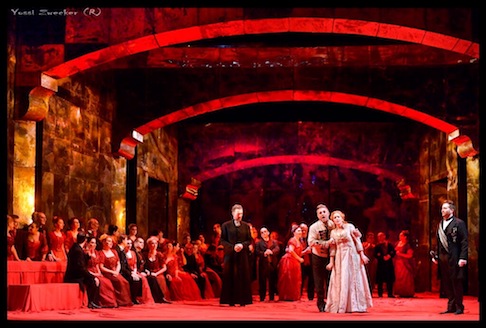
A sharply dressed up Israeli Opera Chorus by Imme Moller served as an additional backbone to the astounding soloists. The IOC, coached by Ethan Schmeisser, brought a sense of grandeur as the singers fuelled the spectacle with a thrilling energy.
Ms Moreno did not outshine Alexey Dolgov’s Edgardo. The Russian from the Bolshoy was her match. Their romantic chemistry filled the drama with tender love. In one of the most difficult tasks in opera, the follow up to Lucia’s madness aria, Dolgov kept the dramatic momentum moving, touching me deeply with Edgardo’s final aria “Tombe degli avi miei”. He earned that explosive applause.
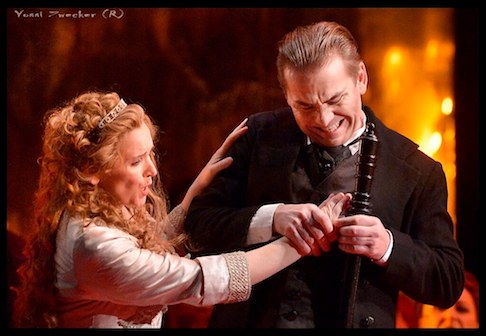
This would have been the perfect introduction to an opera for any newcomer with its persuasively emotive vocals. The Israeli Opera clearly has a nose for casting. Each role role was performed admirably.
Mario Cassi proved a sonorous clashing combatant to Dolgov’s Edgardo during their conflict scene in the opening of the Second Act. Anat Czarny’s Alicia, Lucia’s companion, contrasted Moreno’s virtuous innocence with a darkly edged, wizened tone. As Arturo, Yosef Aridan’s voice fittingly dropped to the background during his interfering moments between Moreno and Dolgov’s fiery chemistry.
Daniele Callegari led the Israel Symphony Orchestra Rishon LeZion and served up Donizetti’s score with lush detail as the orchestra played with great intensity. Although no glass harmonium added to the estrangement of Lucia’s mad scene, Margalit Gafni on her flute did an excellently creepy job at enriching Ms. Moreno’s madness. During the haunting craziness, Mr. Callegari evoked an eeriness just as the expressionistic chills from a Fritz Lang film. By sheer coincidence several evenings earlier, I attended a screening of Metropolis with a new score performed live. In retrospect, it might have been a divination of this sublime afternoon.
As Dolgov’s Edgardo sang “The voice that penetrated my heart,” I felt indeed how Ms. Moreno’s incisive Lucia cut me deep. With such a voice Ms. Moreno could get away with diva attitude, but her thespian camaraderie became clear as she made sure all the performers joined in for the seemingly endless standing ovation. What a treasure she is!
David Pinedo
image=http://www.operatoday.com/Maria%20Jose%20Moreno%20All%20Rights%20Reserved.jpg
image_description=María José Moreno [Photo by Javier del Real]
product=yes
product_title=María José Moreno lights up the Israeli Opera with Lucia di Lammermoor
product_by=A review by David Pinedo
product_id=Above: María José Moreno [Photo by Javier del Real]
All other photos by Yossi Zwecker
April 14, 2017
Cinderella Enchants Phoenix
Stage Director Crystal Manich’s most amusing, well thought out production featured elegant tall building facades from Kentucky Opera that were easily turned around to produce different settings. Designer Kathleen Trott dressed Don Magnifico and his “ugly” daughters in clashing bright colors and textures. The sisters had huge feathers protruding from their coiffures. Don Ramiro and his entourage wore black and white, while the oppressed Angelina wore neutrals. The external settings were serene but the interiors, like their residents, had a great deal of agitation inside them.
Manich directed a group of principals, some of whom were familiar with their roles and had performed them many times. Others, who came from the Arizona Opera Marion Roose Pullin Studio, were singing them for the first time. Two of these young artists showed a great deal of promise. As Dandini, the valet, Joseph Lattanzi sang some incredible coloratura. So did Katrina Galka as Clorinda who sang many fiorature or vocal decorations in her character’s difficult, seldom-performed aria, “Sventurata mi credea” (“I thought I was unlucky”). The stepsisters were expected to create an atmosphere of hilarity. Galka’s Clorinda and Mariya Kaganskaya’s Tisbe kept the laughs coming.
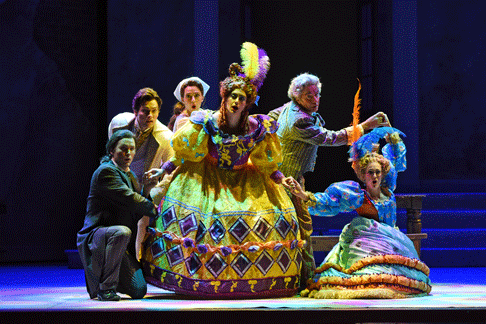 Joseph Lattanzi, Alek Shrader, Daniela Mack, Mariya Kaganskaya, Stefano de Peppo and Katrina Glaka as Dandini, Don Ramiro, Angelina, Tisbe, Don Magnifico and Clorinda
Joseph Lattanzi, Alek Shrader, Daniela Mack, Mariya Kaganskaya, Stefano de Peppo and Katrina Glaka as Dandini, Don Ramiro, Angelina, Tisbe, Don Magnifico and Clorinda
Together, this group of fine artists produced a comic whole that will be remembered long after they have departed for their next engagements. As Angelina, Daniela Mack had a strong voice that cut through the orchestra instead of being heard over it, and featured a huge gleaming bloom above the staff. As Don Ramiro, Alek Shrader’s voice was more lyrical. He sang his long melodic lines with a delightfully sweet, open sound and impeccable coloratura.
Stefano de Peppo who has sung Don Magnifico around the world and across the United States, is known for his large, robust bass-baritone voice. It was fascinating to see him do this role in two different conceptions of the opera, last fall at San Diego Opera and this spring at Arizona Opera. The San Diego company performed a shorter, happier version that cut references to Don Magnifico having supported his household on Angelina’s inheritance. By including that information, Arizona Opera gave good reasons for the Don’s cruelty toward one of his daughters. Best of all, the longer version of the score allowed De Peppo to sing more of his incredibly accurate patter. As the tutor, Alidoro, Zachary Owen was a somewhat mysterious scholar who did not need magic to bring about the fairy tale’s happy ending.
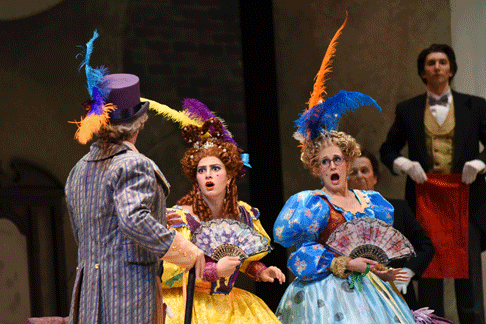 Mariya Kaganskaya and Katrina Galka as Tisbe and Clorinda
Mariya Kaganskaya and Katrina Galka as Tisbe and Clorinda
Directed by Henri Venanzi, male members of AZ Opera chorus rendered their harmonious music in royal style. Conductor Dean Williamson's orchestra sounded a bit rough at the beginning of the overture and the singers’ opening lines were slightly off the beat. For the rest of the performance, however, stage and pit were in perfect coordination. I love Williamson’s version of this opera. Clorinda’s aria was a gem to be treasured. This performance of Cinderella was a delight for young and old alike. Both age groups were well represented in this enthusiastic audience.
Maria Nockin
Cast and production information:
Cinderella/Angelina, Daniela Mack; Don Ramiro, Alek Shrader; Dandini, Joseph Lattanzi; Don Magnifico, Stefano de Peppo; Clorinda, Katrina Galka; Tisbe, Mariya Kagankaya; Alidoro, Zachary Owen. Conductor, Dean Williamson; Stage Director, Crystal Manich, Costume Designer Kathleen Trott; Lighting Designer, Gregory Allen Hirsch; Chorus Master, Henri Venanzi.
image=http://www.operatoday.com/Cinderella-5.png
image_description=Daniela Mack and Alek Shrader as Angelina and Don Ramiro [Photo by Tim Trumble]
product=yes
product_title=Cinderella Enchants Phoenix
product_by=A review by Maria Nockin
product_id=Above: Daniela Mack and Alek Shrader as Angelina and Don Ramiro
Photos by Tim Trumble
LA Opera’s Young Artist Program Celebrates Tenth Anniversary
Sondra Radvanovsky opened the program with a rendition of the Bolero from Giuseppe Verdi’s I Vespri Siciliani, “Merce, dilette amiche” (“Thank you dear friends”). At first she seemed still to be warming up, but her voice soon attained its usual lustre and radiant qualities. Later, she sang a heart rending version of “Senza Mamma” (“without Mama”) from Giacomo Puccini’s Suor Angelica. She sang two duets with Domingo who was in marvelous voice for this auspicious occasion. They joined their voices in the revealing “Orfanella il tetto umile” (“An Orphan under a Humble Roof”) from Verdi’s Simon Boccanegra and the sophisticated “Lippen Schweigen” (“Silent Lips”) from Johann Strauss’s Die Fledermaus.
Although Diana Damrau and Nicholas Testé, who are currently appearing in LA Opera's production of The Tales of Hoffmann were expected to sing at the concert, their health issues did not allow it. However, with the profusion of talent available among the members of past and present LAO Young Artist Programs, the concert provided an excellent showcase.
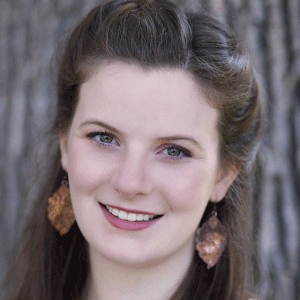 Liv Redpath
Liv Redpath
Unlike most opera concerts, this program included ensembles. For the Rigoletto Quartet, “Bella figlia dell’amore” (“Beautiful Daughter of Love”), Kihun Yoon was a lyrical Rigoletto, Hyesang Park a refined Gilda, Joshua Guerrero a warm-voiced Duke and Renée Rapier an experienced Maddalena who did not fall for one word of the Duke’s flattery. A different group, consisting of Carlos Enrique Santelli, René Rapier, So Young Park, Michelle Siemens, Theo Hoffman, and Nicholas Brownlee, sang the smartly contrapuntal but rather slow moving sextet “Siete voi? . . . Questo è un nodo avvilupato” (“Is that you? This is a tangled knot”) from Gioachino Rossini’s Cinderella.
Duets abounded. First year program member Liv Redpath showed not only the beauty of her mid-sized voice but also a talent for comedy when she sang “Pronto io son” from Gaetano Donizetti’s Don Pasquale with equally talented program member Theo Hoffman. I can’t help thinking that one of Joshua Guerrero’s daydreams was to sing with Domingo. With robust tones, the young tenor and the tenor-turned-baritone sang “Au Fond du Temple Saint” from Georges Bizet’s The Pearlfishers.
From Mozart’s The Marriage of Figaro, Lauren Michelle as Susanna and Summer Hassan as the Countess sang an exquisite rendition of “Sull’aria . . . Che soave zeffiretto” (“On the air...The soft breeze”) and from Donizetti’s Lucia di Lammermoor, Hyesang Park and Guerrero sang “Verranno a te” (“They will come to you”) in lovely bel canto style. One of the great delights of Vincenzo Bellini’s I Puritani is its duet for lower male voices, “Suoni la tromba” (“Sound the Trumpet”). While Kihun Yoon and Nicholas Brownlee did not have the decibel power of some of the vocal stars best known for this duet, they sang it with well focused tones and and were greeted with plentiful bravos at the finish.
Some artists displayed their special talents with solo arias. Nicholas Brownlee has a wide range of dynamics and the aria “La lluvia ha cesado” (“The Rain has Stopped”) from Ruperto Chapi’s zarzuela La Tempestad allowed him to start softly, make a huge crescendo to illustrate a severe storm, then show the peaceful ambience that follows such a storm. When Brenton Ryan sang “Oh, the Lion may Roar” from John Corigliano’s The Ghosts of Versailles, he seemed to be channeling Hollywood actor Frank Gorshin. The piece tells of the invincibility of the common worm and was a perfect vehicle for this opera "bad guy" who sang with a scary style.
The Queen of the Night’s arias from The Magic Flute hold no terrors for So Young Park and she easily tossed off “O zittre nicht” (“Don’t tremble”) for this appreciative audience. Lauren Michelle, a 2015 prize winner at the BBC Cardiff Singer of the World Contest, delighted this audience with Jules Massenet’s “Dis-moi que je suis belle” (“Tell me that I’m beautiful”) from Thais.
Then the champagne began to flow backstage and Hyesang Park appeared with a tilted glass of bubbly. Singing “No se qué siento aqui” (“ I don’t know here”) from Manuel Fernandez Caballero’s Chateau Margaux with bell-like tones, she began the finale, which included the entire cast singing the “Champagne Song” from Johann Strauss’s Die Fledermaus. Since Placido Domingo sang duets with Radvanovsky and Guerrero, LA Opera veteran conductor Grant Gershon led several of the selections at comfortable tempi. However, Domingo led most offerings with his well known verve and joie de vivre.
Maria Nockin
image=http://www.operatoday.com/LAO-Radvanovsky.png
image_description=Sondra Radvanovsky
product=yes
product_title=LA Opera’s Young Artist Program Celebrates Tenth Anniversary
product_by=A review by Maria Nockin
product_id=Above: Sondra Radvanovsky
Extravagant Line-up 2017-18 at Festspielhaus in Baden-Baden, Germany
Once you arrive at the main train station, you sense you’re in a rare place utterly at peace in a world in chaos. This magic bubble equals the serenity of Lucerne in Switzerland. In the middle of Germany’s Black Forest, since Roman times Baden-Baden is also renowned for its hot water springs that make it famous spa retreat. During the festivals, the musicians of the visiting orchestras give Meisterkonzerte of chamber music at the legendary Kurhaus, the modern art museum Frieder-Burda, and at the casino glamorous enough for a James Bond film.
Before the end of the 2017 season, there is a lot more opera to hear. This Easter for ten days, Simon Rattle and the Berliner Philharmoniker perform exciting programmes with impressive soloists. In recent years, they have alternated Puccini with Wagner. With Manon Lescaut two years ago, last year the world premiere of the NYC Met’s Tristan und Isolde, and this year Tosca and an evening with Anne Sofie von Otter.
Next Easter, an all star line-up with Stephen Gould, Evelyn Herlitzius, and Evgeny Nikitin in Parsifal will join for Rattle’s last season with the Philharmonic. In additional programming, Krystian Zimerman, Gerald Finley and Elina Garanca will also perform solo with the Berliners.
Also during Easter, in the tiny Theater Baden-Baden, the young musicians of Berliner Philharmoniker Academy present chamber opera adaptations. Last year, a witty, highly engaging version of Haydn’s Il mondo della luna delighted audiences. This year Peter Brooks abridged La Tragedie de Carmen gets a new staging, while next year Mozart’s La finta giardiniera gets tackled. Just a visit to the theater for its baroque ceiling is worth your time.
Last year for its annual star-studded Summer Gala, Jonas Kaufmann, Ekaterina Gubanova, Bryn Terfel, and Anja Harteros wowed the audience. This year, Yannick Nézet-Séguin and the Chamber Orchestra of Europe perform a concert version of La Clemenza di Tito with Joyce Didonato and Rolando Villazón. In 2018, the Might Mouse (Didonato’s nickname for the Maestro) will return with The Magic Flute.
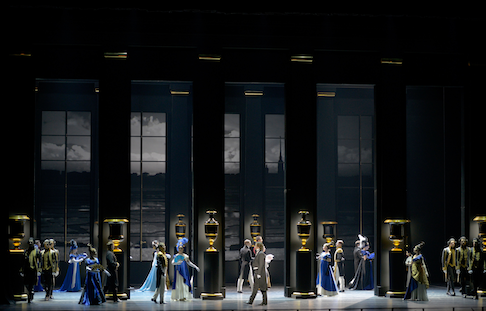 Eugene Onegin © V.Baranovsky
Eugene Onegin © V.Baranovsky
Russian powerhouse Gergiev returns twice a year with his Mariinsky troupe. Late July, two stagings of Eugene Onegin bookend two rich programs. One evening he present Rachmaninoff’s Third Piano Concerto with Trifonov behind the piano and the composer’s choral symphony The Bells. The next evening, both Chopin Piano Concertos with Bruckner’s Seventh in between will exhaust the audience. In the Winter Gergiev returns with lavish ballet programs.
Next season’s line-up during the Fall, includes Rene Jacobs, who brings a concert version of Beethoven’s original version Leonore. In November, La bohème is staged. Bartoli and Villazón drop by on two occasions. During the Winter months of January and February, Damrau & Kaufmann, Harteros, and an Operetta Gala with Thomas Hampson, Marlis Petersen, and Piotr Beczala will warm up the audiences.
In Spring, Diana Damrau returns with her hubby Nicolas Testé for a night of Verdi. Olga Peretyatko and Sonya Yoncheva come over for two separate recitals. Bryn Terfel stars in a concert version of Wagner’s Der fliegende Holländer led by Gergiev. Iván Fischer and his Budapest Festival Orchestra will provide another highlight with Mahler’s Second Symphony.
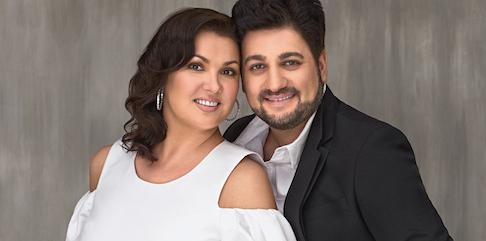 Anna Netrebko and Yusif Eyvazov copyright by Vladimir Shirkov
Anna Netrebko and Yusif Eyvazov copyright by Vladimir Shirkov
And in the Summer, the season will have a climactic ending as Gergiev returns to conduct Anna Netrebko and Yusif Eyvazov in Francesco Cilea’s Adriana Lecouvreur in a staging by Isabelle Patriot-Pieri from the Mariinsky Theater.
Feel free to bring the (grand)children: kids’ programming will certainly stimulate them, so you can put them to bed early and enjoy your evening.
Here the private sponsoring certainly does not go to waste on poor programming!
image=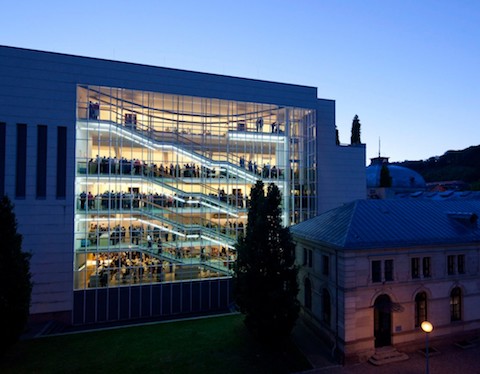
product=yes
product_title= Baden-Bade season highlights
product_id=Above: Festspielhaus Baden-Baden by Myrzik and Jarisch
Gerhaher and Bartoli take over Baden-Baden’s Festspielhaus
Schubert’s Die Winterreise
On Friday evening, German national hero Christian Gerhaher came down to the Festspielhaus to perform Schubert’s Die Winterreise for a full house. Injured on his leg, the renowned baritone limped onto stage. No matter, his vulnerable yet resilient voice in his usual dour intonation, brought out the emotional complexities of Schubert’s famous song cycle.
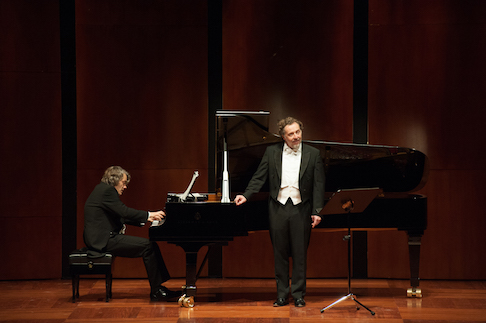 Gerhaher and Huber © Michael Gregonowits
Gerhaher and Huber © Michael Gregonowits
Perhaps it was the giant setting of the Festspielhaus, but intimacy lacked in the experience. Yet Gerhaher made the best of it, alternating his somber mist with frequent bursts of fiery energy. He definitely knows how to shine a light on Schubert’s masterpiece.
Tobias Haslinger’s Romantic poetry came alive through Gerhaher’s nuanced phrasing. His voice captures the listener’s ear and sustains a tension from his convincing sorrow that seems to be emanating from a tortured soul. He charged all of Schubert’s songs with endless sadness, while his weariness also brought out Schubert's bitter perspective on life’s unrequited love.
In “Wasserflute” (Flood) he mellowed out a bit creating a more contemplative ambience. This calmer softness allowed for a bit of levity. Later, with bulging eyes, he built up to the last song to a ferocious climax in a fortissimo in which he appeared to drain the last of his stamina.
Gerold Huber balanced Gerhaher with invigorating piano play. He created an upbeat contrast to Gerhaher’s heavy-handed presence. In the final song “Der Leiermann” (The Hurdy-Gurdy Man), Huber’s spectacular play complemented the baritone’s great vitality. He offered the perfect accompaniment.
Towards the end, it was impossible not to feel entranced by Schubert’s passion and haunting melancholy. Clearly enamored by tonight’s resonating depth, the elderly couple next to me tenderly carressed each other’s hands throughout the evening.
Bellini’s Norma
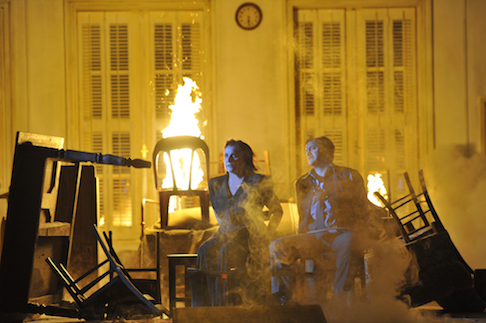 Bartoli in Norma © Hans Joerg Michel
Bartoli in Norma © Hans Joerg Michel
In 2013 at her Salzburg Whitsun Festival, Cecilia Bartoli starred in this production of Norma that then travelled to Zurich, Edinburgh, and Paris. Baden-Baden was its last stop, and the production was at the end of its momentum.
A lyrical tragedy in two acts with a libretto by Felice Romano, Vincenzo Bellini’s bel canto opera tells the story of Norma fighting with the Druid resistance in pre-France fighting against the Roman invasion. Along the way she deals with a love triangle, in which she eventually commits suicide with the Roman Pollione, who had fallen in love with the priestess Adalgisa.
However, in their production, for no reason, Patrice Caurier and Moshe Leiser inexplicably transplaced the story to more recent times. They set Norma (during the WWII...I think) in a 20th Century classroom set, which did bring an intimate atmosphere with lots of dramatic tension. Norma and Pollione's burning deaths made for a sensational climax.
It was the first time I heard Madama Bartoli live, so I was surprised to be more impressed by her co-star Rebeca Olvera. Bellini’s premature high point, the famous “Casta diva” did not reach the emotional heights I was hoping for. Still, hearing Bartoli’s coloratura with all her bends and turns, put a smile on my face, and her dramatic resonance certainly filled up the otherwise uneventful staging.
Although I expected Ms Bartoli to dazzle, it was soprano Rebeca Olvera who stole my heart as Adalgisa. I was crushed by the Mexican’s performance; both in her rich contrast to Bartoli’s lighter touch; as well as in her desperation and anguish during her high-strung passages. Norman Reinhardt as Pollione seemed a bit lost, but delivered swell vocals. In addition, the Coro della Radiotelevisione svizzera filled up the stage with terrific surges of energy.
Gianluca Capuano with I Barocchisti replaced Diego Fasolis, Bartoli’s usual conductor. Even with the extraordinary acoustics of the Festspielhaus, the orchestra sounded muted. Perhaps the conductor intended not to overshadow the lithe, but demure mezzo voice of Ms. Bartoli. Though what strength her voice missed for Norma, Ms. Bartoli made up in her alluring presence. With her ravishing, brunette turbo hair spiraling from her head, she’s a powerhouse actress that draws the spotlight to her while on stage.
With Norma not living up to the great expectations I usually have satisfied in Baden-Baden, it was the next day with Frau Mutter, who truly stunned me with her focused and dizzyingly romantic Mendelssohn’s Violin Concerto, followed by Ticciati’s engaging performance of Dvorak’s New World Symphony. Her perfect play swooning in its romance proved a sensational ending to this extravagant weekend.
David Pinedo
image=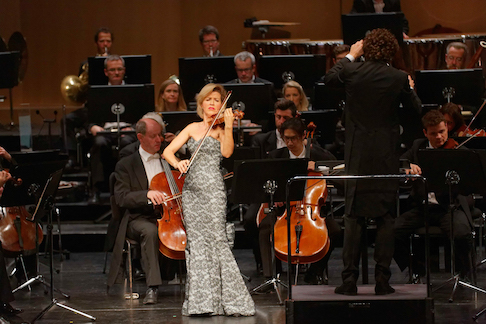
product=yes
product_title=Gerhaher and Bartoli take over Baden-Baden's Festspielhaus
product_by=A review by David Pinedo
product_id=Above: Anne-Sophie Mutter with Ticciati and LPO


April 11, 2017
Mahler Symphony no 8 : Jurowski, LPO, Royal Festival Hall, London
What it lacked in interpretive depth was made up for in being well performed, and more than compensated by the imaginative verve of the semi-staging and the way it highlighted structural ideas in this symphony.
Intriguing questions. Why, for example, preface a two- hour symphony with the ten-minute Thomas Tallis Spem in alium ? The motet is written for forty parts in eight groups of five voices, mirroring the five voice types of the soloists in the symphony. Tallis's text refers to the "Creator caeli et terrae", while Mahler refers to the hymn "Veni, Creator Spiritus" marking the Pentecost, where a divine flame appeared to the faithful, charging them with spreading the gospels to the world. Six hundred years separate the Maurus hymn from Tallis, but in Mahler, the ancient past is re-created for modern times. Thus a sense of primeval continuity, as if an Urlicht were descending upon those who perform and listen to the symphony. Hardly had the singing faded when Jurowski led the orchestra straight into the symphony, without pause. From exquisitely balanced unaccompanied harmonies to the explosive chords of the organ. The "Shock of the New" in every way, for Mahler's Symphony no 8 is unique in so many ways. Thus anointed, we were prepared for Mahler's journey into new territory
This juxtaposition of Tallis and Mahler came perhaps from the concept "Belief and Beyond Belief" the theme of the LPO's year-long series. By no means are all beliefs Christian. While the First Part of the symphony is shaped in the liturgy of the past, the Second Part, despite its references to saints, is secular, based on Goethe's Faust and on a highly unorthodox blend of lust, sin, death and redemption. Gretchen wasn't a virgin, yet Faust is saved by her intervention. Das Ewig-wiebliche, the "Eternal Feminine" for Mahler was entirely personal, and very much as odds with conventional morality.
Thus the logic in this case of inserting an interval between the First and Second Parts of the symphony, which otherwise should be sacrilege. The two Parts of the symphony are meant to be played together without a break, since the slow, quiet beginning of the Second Part acts as an important transition, a kind of "Purgatory" between one plane and another. To split the two parts to make way for a drinks interval is musically inappropriate - Mammon polluting the Temple - the prerogative of philistines. But in this performance, the interval made sense, because it emphasized that the difference between the two parts represents a shift in metaphysics more profound than musical logic. Context is everything, and hopefully audiences will be sophisticated enough to realize that this exception should not become the rule.
The name "Symphony of a Thousand" was not Mahler's idea, but a slogan created by the promoter of the premiere, who realized how the blockbuster aspects of the symphony could be marketed. Because of its sheer theatrical impact, this massive symphony will always be stunning. But as Mahler so explicitly states, the vast forces are bearers of "poetic thoughts", so powerful that they need ambitious expression. It's not spectacle for the sake of spectacle, not a circus for pulling stunts of sheer people management. While volume may be exciting, quantity most certainly is not more important than quality. Both times that I've heard Mahler's Eighth in the Royal Albert Hall, the results weren't convincing since the sound dissipated badly under the cavernous dome.
The Royal Festival Hall seats 2900, so a thousand players would be deafening. Fortunately, Jurowski got around the problem by spreading the singers around the performance space, instead of concentrated in one focal point, deafening audience and orchestra. Sometimes the choirs ranged around the side galleries, where they were heard clearly and to full effect. Wonderful hushed singing, barely above whisper: in a symphony as big as this, that's something special. When the choirs were positioned behind the orchestra, they operated as individual units for the most part until the glorious finale. What a pleasure it was to hear each group distinctly, as opposed to hearing them blended en masse. Much respect for them, singing so well and so clearly, despite rushing about. Incidentally, positioning the choirs in the side galleries resembled the "horseshoe" formation adopted in some early music ensembles The soloists at first appeared in a line between orchestra and choirs. the "sweet spot" in the Royal Festival Hall acoustic. This lessened the strain : no-one forced to shout to be heard.
In the Second Part, the soloists moved positions much more than they do normally. One expects the Mater Gloriosa to sing from on high like an angel, but the other singers moved around, too, especially the women, and Matthew Rose remained surrounded by the orchestra, his deep bass carrying well over the sounds around him. Choirs in motion, singers in motion, but not nearly as distracting as one might fear. The Second Part of this Symphony was inspired by art to which modern perspective did not apply. Thus figures float about disconnected to the landscapes behind them, as oddly as lions behaving like lambs. Similarly, Goethe's Faust depicts unnatural movement - flying through skies, ascension into heaven and so forth. The textures in Mahler's orchestration suggest multiple levels and layers and interesting combinations of instruments and voice. The symphony is constantly in motion.
Throughout Mahler's Symphony no 8, images of light and illumination recur. In this performance, lighting effects (Chahine Yavroyan) were used to emphasize contrasts. Small lights, flickering above the music stands, helping the players follow the page while the hall was in darkness. Large spotlights , highlighting groups of choristers as they sang. The Royal Festival Hall organ, usually hidden behind a screen, was fully open, lit in rich shades of sapphire, alternating gold, and towards the end, silver and iridescence. The organist was James Sherlock.
The presence of microphones in the hall suggested that a recording or broadcast may be available at some stage. All live performances have something extra: this Jurowski/LPO Mahler Symphony no 8 was unique, an experience never to forget.
Soloists were : Judith Howarth, Anne Schwanewilms, Sofia Fomina, Michaela Selinger, Patricia Bardon, Barry Banks, Stephen Gadd and Matthew Rose. Choirs were the London Philharmonic Choir, the London Symphony Chorus, the Choir of Clare College, Cambridge and the Tiffin Boys' Choir.
Anne Ozorio
image=http://www.operatoday.com/Jurowski_Vladimir_PC_Drew-Kelley_b_72.png
product=yes
product_title=Thomas Tallis : Spem in alium, Gustav Mahler : Symphonu no 8, Vladimir Jurowski, London Philharmonic Orchestra, Royal Festival Hall, London, April 8th 2017
product_by=A review by Anne Ozorio
product_id= Vladimir Jurowski, courtesy IMG Artists
April 9, 2017
Rameau's Les fêtes d'Hébé, ou Les talens lyriques: a charming French-UK collaboration at the RCM
When Les fêtes d'Hébé appeared in 1739 Rameau was at the height of creative powers and popularity. Masterpieces such asHippolyte et Aricie, Les Indes galantes and Castor et Pollux had flowed from his pen in the preceding few years, and Les fêtes d'Hébé was one of his most acclaimed works during his lifetime, receiving nearly 400 performances after its premiere, before gradually fading from the repertory following the composer’s death in 1764.
It seems incredible, therefore, that Les fêtes d'Hébé has not previously been staged in the UK. All credit, then, to the combined forced of the Royal College of Music, the Académie de l’Opéra national de Paris, and the Centre de musique baroque de Versailles for bringing Rameau’s charming, colourful ‘entertainment’ to London for the first time.
Les fêtes d'Hébé presents considerable challenges, though, and not all the outcomes were successful. First, the ‘tale’ Rameau tells is slight, the three parts hanging together by the slenderest of threads. Hébé, the goddess of youth cupbearer of the gods, is bored with life on Olympus and irritated by the unwanted amorous advances of Momus. So, with her retinue of Graces, she wings it down to earth in search of other delights, alighting on the banks of the Seine, where Cupid advises her to mount a spectacle in celebration of the three talens: ‘la poésie’, ‘la musique’ and ‘la danse’.
(And, indeed, where better than the environs of L’Opéra to enjoy such ‘talents’, for in the early eighteenth century, with the Revolution still fifty years away, this Parisian institution remained the preferred gathering place for high society and intellectuals, and a symbol of the glory of the French monarchy.)
So, much like the English masque, the opera-ballet has no plot worth mentioning but lots of visual spectacle and flamboyance together with elaborately engineered stage effects. Can the refined aesthetic of the eighteenth century - the highly ornamented and stylised cadences, the gentle artifice, the convoluted ‘narrative’ - be made appealing to twenty-first-century audiences?
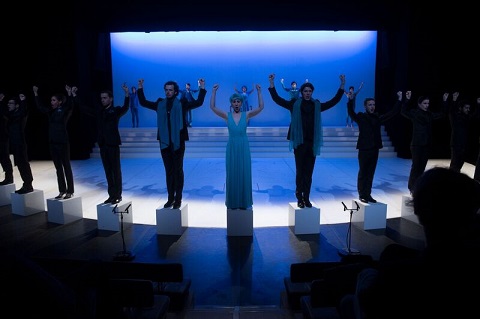 James Atkinson, Eleanor Penfold, Joel Williams. Photo credit: Studio J'Adore Ce Que Vous Faites.
James Atkinson, Eleanor Penfold, Joel Williams. Photo credit: Studio J'Adore Ce Que Vous Faites.
With a budget considerably less than that enjoyed by François Boucher when he supervised the set designs at the Palais-Royal theatre in 1739, Thomas Lebrun (director, set designer and choreographer), Françoise Michel (lighting designer) and Laurianne Scimemi Del Francia (costume design) went for a minimalist, colour-themed approach, bathing each of the acts in a single hue - blue, yellow and red - and adding some bucolic projections. The result was stylish and clean, but not particularly helpful in terms of communicating who was who and what they were doing as they repeatedly and randomly moved small white blocks about the stage. The cast is large and the singers and dancers reappear in different roles. It all looked pretty but I didn’t have much idea what was going on.
Lebrun’s choreography was fairly abstract but lithely danced and not unappealing. It didn’t seem designed to serve a ‘dramatic’ function, though. The modern idiom was also somewhat at odds with the musical aesthetic, in a work in which dance, song and choruses come and go with integrated fluidity. Some of the abundant dance numbers are adapted from harpsichord pieces Rameau had previously published and the music is ravishing. One can agree with Charles Burney who wrote in 1789, ‘More genius and invention appears in the dances of Rameau than elsewhere, because in them, there is a necessity for motion, measure, and symmetry of phrase.’ However, Lebrun did place the ballet, particularly in Terpsichore’s final apotheosis of the art of dance, at the heart of the entertainment, and sequences such as that which accompanied the Oracle’s announcement of Tyrtaeus’ victory in the second act were absorbing.
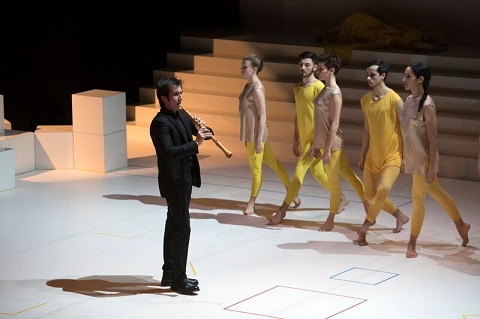 Andres Villalobos as Palemon (Oboe). Photo credit: Studio J'Adore Ce Que Vous Faites.
Andres Villalobos as Palemon (Oboe). Photo credit: Studio J'Adore Ce Que Vous Faites.
The original cast comprised some of the greatest French singers of the period, and the vocal performances here confirmed that there is a lot of talent in the conservatoires of France and the UK. Rameau’s vocal writing is elegant, expressive and well-placed for the singers if rather lacking in variety and range of character. On the whole the soloists coped well with the curlicues and artifice though inevitably they struggled to imbue much depth into the characterisation. Adriana Gonzalez displayed a rich, plump soprano as Sapho/Iphise while Pauline Texier soared smoothly at the top as Hébé in the Prologue and was an engaging Églé in the final Act, wooing Juan de Dios Mateos’ arrogant Mercury with charming persistence. Tenor Joel Williams revealed an alluring voice as Oracle/a stream (there’s a part for ‘a river’ too …), and Eleanor Penfold, a Naiad, joined him in a delightful duet in Act 1 during a fête galante mounted by Sapho to celebrate their reunion. Tomasz Kumiega displayed a sure sense of the style. The French chorus (directed by Olivier Schneebeli) were terrific.
Conductor Jonathan Williams pushed things along at quite a lick, sometimes at the expense of the intonation and the insistent pace could not have aided the singers’ efforts to inject some depth into their roles. Moreover, pastoral needs a little more languor; and the small string section of the Royal College of Music Baroque Orchestra inevitably could not summon the richness that Rameau’s original audiences must have enjoyed.
Can a modern audience be made to care about the amorous shenanigans of Sapho, Iphise and Mercury, or be absorbed by injustices and restorations among mythical kings and deities? Probably not. The French baroque opéra-ballet is an acquired taste and one not naturally suited to modern palettes. But, this ambitious production offered visual and aural enjoyment and the three collaborating institutions should be lauded for their efforts and for bringing Les fêtes d'Hébé to life.
Claire Seymour
Jean-Philippe Rameau: Les fêtes d'Hébé
Hébé/Églé - Pauline Texier, Sapho-Iphise - Adriana Gonzalez, Amour/Cupid - Laure Poissonnier, Momus/Lycurgus - Jean-François Marras, Thelemus/Mercury - Juan de Dios Mateos, Hymas/Tyrtaeus - Mikhail Timoshenko, Alcaeus/Eurilas - Tomasz Kumiega, A stream/A shepherdess - Julieth Lozano, Naiad/A shepherdess - Eleanor Penfold, Oracle/A stream - Joel Williams, A river - James Atkinson, Dancers - Karima El Amrani, Antoine Arbeit, Maxime Camo, Lucie Gemon, Léo Scher, Julien-Henri Vu Van Dung; Director/Set Designer/Choreographer - Thomas Lebrun, Lighting Designer - Françoise Michel, Costume Designer - Laurianne Scimemi Del Francia, Royal College of Music Baroque Orchestra, Les Chantres, singers of the Centre de musique baroque de Versailles (director Olivier Schneebeli).
Britten Theatre, Royal College of Music, London; Thursday 6th April 2017.
image=http://www.operatoday.com/Laure%20Poissonnier%20as%20Amour%20%28Cupid%29%20%28c%29%20studio%20j%27ado%E2%80%A6e%20vous%20faites.png image_description=Les fêtes d'Hébé, ou Les talens lyriques, Royal College of Music product=yes product_title=Les fêtes d'Hébé, ou Les talens lyriques, Royal College of Music product_by=A review by Claire Seymour product_id=Above: Laure Poissonnier (Amour)Photo credit: Studio J'Adore Ce Que Vous Faites
April 8, 2017
The Royal Opera House announces its 2017/18 season
New productions:
The Royal Opera’s Season includes six new productions at the Royal Opera House.
A new production of La bohème will be directed by Richard Jones. David Alden will direct Semiramide and Lohengrin : the latter, which will be conducted by Andris Nelsons - returning to the House after his outstanding performances of Der Rosenkavalier earlier this season - is the first staging of the opera at the Royal Opera House since 1977. Barrie Kosky, returning to the House after his critically acclaimed 2016 production of The Nose will direct Carmen . One of the Season’s highlights’ will surely be From the House of the Dead directed by Polish theatre director Krzysztof Warlikowsi, making his UK debut - a production which will initiate a complete survey of Janáček’s operatic oeuvre during the next six years. The Season will also see the world premieres of George Benjamin ’s new opera, Lessons in Love and Violence directed by Katie Mitchell and Donizetti’s L’ange de Nisida , conducted by Mark Elder 179 years after it was completed.
Antonio Pappano will conduct two new productions as well as revivals of Macbeth (starring Serbian baritone Željko Lučić in the title role and Russian soprano Anna Netrebko as his ambitious, scheming wife) and Lady Macbeth of Mtsensk.
In La Bohème, Australian soprano Nicole Car and former Jette Parker Young Artist Romanian soprano Simona Mihai will share the role of Mimì, and American tenor Michael Fabiano will tackle the role of Rodolfo for the first time at Covent Garden, following his debut as Lensky in 2015. Joyce DiDonato will take the title role in Semiramide, which she created for Alden’s production when it was given its premiere by the Bavarian State Opera in February 2017. Semiramide was last seen at Covent Garden in 1885 when Adelina Patti sang the title role; a concert performance of the opera was given by the Royal Opera House in 1986.
Pappano, now in his 16th season with The Royal Opera, will also conduct the Orchestra of the Royal Opera House in a concert performance with baritone Christian Gerhaher, and give a recital with Joyce DiDonato.
Revivals:
The Season’s programme also includes first revivals of Olivier Award-winning Cavalleria rusticana/Pagliacci (Simon Keenlyside sings his first Tonio), the much-discussed Lucia di Lammermoor (Michele Mariotti conducts, American-Cuban soprano Lisette Oropesa debuts as Lucia), Les Vêpres siciliennes and Philip Venables’ UK Theatre Award-winning 4.48 Psychosis .
The Season will also see revivals of Rigoletto, Falstaff, Die Zauberflöte and Don Giovanni (as directed by Kaspar Holten, and featuring Mariusz Kwiecień in the title role, which he created in this production in 2014).
Outside the House:
The Season also includes four premieres away from the Royal Opera House in collaboration with a range of partners, co-producers and co-commissioners: the world premieres of Mark-Anthony Turnage ’s new opera Coraline at the Barbican Centre; Mamzer Bastard by Guildhall School of Music & Drama/Royal Opera Composer in Residence Na’ama Zisser; and a new work by Tansy Davies produced by London Sinfonietta in association with The Royal Opera.
The Return of Ulysses will be performed at theRoundhouse, andLa tragédie de Carmen will be performed at Wilton’s Music Hall by members of the Jette Parker Young Artist programme.
The Royal Opera will collaborate with the V&A for an exhibition covering almost 400 years of operatic history: Opera: Passion, Power and Politics , which opens in September 2017.
Looking ahead to the 2018/19 Season, four full cycles of Keith Warner’s production of Der Ring des Nibelungen will be performed between September and November 2018; booking details will be available in autumn 2017.
During the 2017/18 Season, 12 productions — six from The Royal Opera and six from The Royal Ballet — will be relayed live from Covent Garden to cinemas around the world. The programme features a mixture of new productions and classic works. Find your nearest cinema.
image= http://www.operatoday.com/ROH%20logo.png image_description= product=yes product_title= product_by= product_id=April 7, 2017
St Matthew Passion: Armonico Consort and Ian Bostridge
A devout Lutheran, Bach frequently framed his manuscript scores with the opening and closing annotations, ‘JJ’ (Jesus Juva, Help me Jesus) ‘SDG’ (Soli Deo Gloria, Glory to God alone) respectively. However, though it was designed a liturgical context with its two parts performed either side of a sermon, the St Matthew Passion is inherently dramatic. The opening calls and responses of its two orchestras and two choruses have the grandeur and gravitas, animation and restlessness of opera. And, it’s a drama in which the congregation or audience are invited, no compelled, to participate: ‘Kommt, ihr Töchter, helft mir klagen’ (Come, ye daughters, help me to lament) is the chorus’s opening cry.
Several directors, Penny Woolcock, Thomas Guthrie, Jonathan Miller and Peter Sellars among them, have presented staged versions of the St Matthew Passion, but this performance at St John’s Smith Square by the Warwickshire-based Armonico Consort and Baroque Orchestra, conducted by director Christopher Monks, needed no visual dimension to achieve its theatrical impact.
Monks’ conception of the work is one in which a quasi-mythic fatalism forces the drama unstoppably and inevitably onwards. Arias and choruses followed recitatives with scarcely a breath between them; the recitatives themselves pushed forwards towards the choric or soloistic declarations. ‘Answers’ began before the inquisitorial dust had settled. It was breathless and exciting; also terrifying. After all, we know how the ‘story’ ends.
Monks also placed choric communality at the heart of the Passion. After the remarkably transparent interplay of the dense vocal and instrumental textures of the opening chorus, in which soprano and tenor lines pushed themselves to the forefront and orchestral arguments twisted knottily, the first Chorale, ‘Herzliebster Jesu’ (Dearest Jesus), set a tone - blended, poised, yet questioning - which was sustained to the close. The chorale phrases had both strength and elasticity, and Monks’ instinct - when to push on, when hold back - was sure.
The first appearance of the ‘Passion chorale’ (‘Erkenne mich, mein Hüter’, Recognise me my shepherd) was gentle, almost vulnerable; its immediate repetition more invigorated and pressing - ‘Dein Mund hat mich gelabet’ (You mouth has succoured me). Then, greater urgency drove the dynamic upwards, and vocal enjambment (even when not indicated by the punctuation of the text) created an inexorable trajectory towards tragedy: ‘Wenn dein Herz wird erblassen,/im letzen Todesstoß,/ als denn will ich dich fassen/ in meinen Arm und Schoß’ (If your heart becomes pale in the throes of death then I will grasp you in my arms and draw you to my bosom).
The warmth of the chorale ‘Was mein Gott will, das gscheh allzeit’ (What my God wishes, may that always happen) conveyed spiritual confidence; the dominance of the sopranos’ angelic purity in the Part 2 chorale, ‘Bin ich gleich von dir gewichen’ (If I have strayed from you), together with uncharacteristic hesitancy between phrases conveyed penitence. The choristers of St Mary’s Collegiate Church, Warwick, added a further patina of redemptive transcendence to the pivotal chorales.
The voices of the bewildered disciples and pious onlookers emerged from the chorus, emphasising the collective experience, and the exhilarating interplay between solo and choral voices reached a height when Jesus was captured in Gethsemane. ‘So ist mein Jesus nun gefangen’ (My Jesus is now captured’ mourned soprano Hannah Fraser-Mackenzie and alto Polly Jeffries, to the light accompaniment of upper strings and woodwind; but their forbearing lament thrust was aside by the agitated, raging chorus, ‘Laßt ihn, haltet, bindet nicht!’ (Leave him, stop, do not bind!).
The choral soloists were not all equally secure, however. Countertenor Joseph Bolger, replacing the advertised alto Emma Lewis, was rather hooty in the Part 1 ‘Buß und Reu’ (Penance and remorse) and struggled to project in the more elaborate passages; Lewis’s own subsequent address to Christ’s executioners, ‘Erbarm es Gott!’ (May God have mercy!) was characterised by lyrical power and varying colour. In the famous aria after Peter’s betrayal, ‘Erbarme dich, Mein Gott, um meiner Zähren willen!’ (My God, have mercy for my tears), Bolger was affecting, however, the plangent repetitions of the text conveying the singer’s need for God to recognise his suffering, as leader Miles Golding’s eloquent elegy weaved in and out of the impassioned voice, supported by Andrew Durban’s sonorous double bass pizzicato.
Soprano Gemma King’s ringing clarity was wonderfully communicative in the trial scene, ‘Ich will dir mein Herze in Tränen schwimmt’ (Although my heart swims in tears), and she relished the chromatic twists of ‘Aus Liebe will mein Heiland sterben’. James Geidt doubled up competently as Judas and Peter. Bass Michael Hickman was ardent in the recitative preceding ‘Gerne will ich mich bequemen’ and phrased the aria smoothly. Tenor Edward Saklatvala displayed lots of heft and colour in ‘Geduld! Geduld! Wenn mich falsche Zungen stechen’ (Patience! Patience! When false tongues wound me), as Charles Medlam’s viola da gamba obbligato wrapped eloquently around and between the vocal line. Richard Moore showed stamina in crafting the long, dark lines of the bass aria, ‘Komm süßes Kreuz’ (Come sweet cross).
The players of the Armonico Baroque Orchestra sensitively expressed the distress depicted in the text. Soprano Penelope Appleyard’s ‘bleeding heart’ was made tangible by the orchestra’s sighing fall in ‘Blute nur, du iebes Herz’. The oboe plaintively announced the watchman’s call, prefacing tenor Dale Harris’s sensitive arioso in which attentiveness to the text was matched by sure negotiation of the high tessitura. Jenny Janse provided an agile cello accompaniment to the two false witnesses’ defamations.
At the heart of Bach’s Passion is the Evangelist, a survivor of these terrible events whose narrative declamation brings the ancient tragedy into the present. Characteristically, Ian Bostridge was alert to every textual nuance, twisting his tenor around Bach’s cruel decorations, utterly absorbed in the tale he is telling.
Bostridge’s innate appreciation of expressive rubato, his meticulous diction and involvement with the text, his hyper-sensitivity to detail - all the things that make him such a remarkable lieder singer - were abundantly in evidence. The merest of pauses heightened the shock when one of Jesus’s followers raised his sword and ‘smote off’ the ear of the servant of the high priest. A similar slight delay following Peter’s denial of Christ was replete with almost unbearable predictability, the silence exploding angrily, ‘Und er leugnete abermal und schwur dazu’ (And again he denied with an oath).
Emotive colouring and elongation of the text pierced the air with the pain of Christ’s sorrow. Elsewhere, lines were almost ‘thrown away’, as if to suggest Christ’s inner stillness, as when the two false witnesses gave testimony, ‘Aber Jesus schwie stille’ (But Jesus held his peace). The gentleness of Bostridge’s relation of the events of the Crucifixion itself was deeply troubling. And, how many different shapes and colours can a singer find to declaim, ‘sprach er zu ihnen’ (he said unto them)? Bostridge will let you count the ways …
On occasion, the Evangelist seemed to spit out his short phrases - ‘Petrus sprach zu ihm’ (Peter said unto him), ‘Desgleichen saten auch alle Jünger’ (Likewise also said all the disciples) - resentful of Peter and the disciples’ protestations of loyalty. But, at times, particularly in Part 2, Bostridge seemed a stunned observer, delivering a swift response to the question asked by Jesus’s faithful followers, ‘Wo ist mein Jesus hin?’ (Where has my Jesus gone?), as if astonished by speed of the unfolding tragedy, then turning to face the choir and listen to their prayer. Similarly, the Evangelist nodded resignedly as the High Priest asked the crowd for their verdict, the speed of the narration - ‘Sie antworten und sprachen’ - indicating the inevitability of their eager response: ‘Er ist des Todes schuldig!’ (He is guilty of death!)
As Christ, Andrew Davies was not quite imposing enough to counter the emotional extremes of the Evangelist but the words of the Last Supper were firm and vehement: as Davies’ bass rose his ardent tone conveyed an inner anger. And, his focused voice which moved easily and evenly across the registers did convey gravitas and composure in extremity.
Monks proved expertly responsive to Bach’s manipulations of atmosphere and mood. But, while his singers and instrumentalists performed with commitment and warmth, they could not quite match the intensity of the Evangelist’s tragic narration.
I simply cannot find the words to describe the shocking power of Bostridge’s declaration, ‘Und alsbald krähete der Hahn’ (And immediately the cock crowed). Ugly, bitter but beautifully eloquent, this phrase stayed in my mind long after the performance had ended.
Claire Seymour
J.S. Bach: St Matthew Passion
Armonico Consort and Baroque Orchestra
Director: Christopher Monks
Evangelist: Ian Bostridge (tenor)
Christus: Andrew Davies (bass)
St John’s Smith Square, London; Wednesday 5th April 2017.
image=http://www.operatoday.com/Ian%20Bostridge%20%C2%A9%20Sim%20Canetty-Clarke%201.jpg image_description= product=yes product_title=Armonico Consort and Baroque Orchestra at St John’s Smith Square, London product_by=A review by Claire Seymour product_id=Above: Ian BostridgePhoto credit: Sim Canetty-Clarke
April 5, 2017
Pop Art with Abdellah Lasri in Berliner Staatsoper’s marvelous La bohème
Disarming me with its intimacy and genuine vocal chemistry, Hume’s staging caught me off guard. The Australian director’s take on Puccini channelled the vibe of a fresh musical. The result was an exhilarating, fast-paced show that appealed to the young audience, cheering many “bravi” throughout the performance.
Opening the overture, conductor Lahav Shani with dashing aplomb proved to be the musical impetus. In Hume’s concept, we travel back in time as the old man recollects his love for Mimì. The audience sees an elderly man all alone in a chair on stage. By setting the story up as one of Rodolfo’s reminiscences, Hume instantly saturates Puccini’s bohemia with an even thicker layer of nostalgic longing.
With a vibrant Pop Artsy design that triggered memories of Grease and Footloose, Dan Potra’s ultracool aesthetic embellished Hume’s slick production, facilitating the jumps in the story. Yet through her intimate dramaturgy, Hume also charged Puccini’s romantic melodrama with characterful depth. Basking in romance, a crushing “O soave fanciulla” closed the first act. Coy and sweet in her chemistry with the charismatic Lasri, Aleksandra Kurzak’s Mimì falling in love with Rodolfo oozed pure romance…
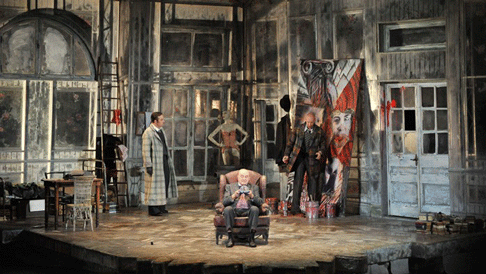 Old Rodolfo reminisces about his past
Old Rodolfo reminisces about his past
Deeply moving from the moment she arrived on stage, Kurzak captured the fragility of her character, presenting the most loveable of Mimìs. Immediately, in “Si, mi chiamano Mimì”, I became enamored by Ms. Kurzak’s virtuous portrayal as a delicate Mimì; by the time she undermines her love for Rodolfo by leaving him in “Donde lieta usci” in the third act, I was smitten.
Arttu Kataja made for an exemplary Marcello in his lustiness for Anna Samuil’s buxom Musetta. At Cafe Momus, they sang with zeal to each other, also joined by Martin Wright’s led choir, which was full of flair. Samuil downright dazzled as Musetta. Her Waltz certainly was a showstopper without being too much of a scene stealing moment from the other characters. She made quite the splash receiving a raucous applause.
Hume effectively contrasted Mimì and Rodolfo’s heartache with the excellently timed biting banter between Musetta and Marcello. The last act burst with gut wrenching drama, culminating in a devastating “Mimì!” from Lasri in utter anguish.
The evening belonged to the Moroccan tenor. The warmth of Lasri’s voice certainly must have warmed Mimì’s hands, as he sang “Che gelida manina”, swooning in romance. Onward, Lasri fueled Puccini’s flames. His voice gushes with personality. He owned Rodolfo. He has superstar wattage that amplifies his robust resonance, all the while serving it up with remarkable authenticity. For me it was the first encounter with this dream tenor, and with great promise, I look forward to Lasri’s future.
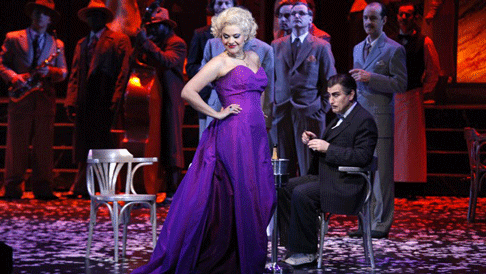 Anna Samuil as Musetta [Photo by Thomas Bartilla]
Anna Samuil as Musetta [Photo by Thomas Bartilla]
Through his vocal theatricality, Lasri also evokes the most devoted rises from the other performers. As the loveable musician, Gyula Orendt’s Shaunard provided the necessary lighthearted overtones. Jan Martiník marked Colline’s benevolence, selling his coat for Mimì’s medicine. He turned “Vecchia zimarra” into a captivatingly poignant farewell to the philosopher’s cherished overcoat. Jonathan Winell delivered laughs as the foolish landlord Parpignol.
Israeli conductor Lahav Shani began the evening with the Berliner Staatskapelle quite loudly, but he quickly balanced his orchestra out with the singers, forming a fine whole. The exquisite saxophone and violin solos touched me deeply, reflecting Shani’s ear for the moving details in Puccini’s score. I look forward to hearing his fierce intensity in the Rotterdam Philharmonic. He will succeed Yannick Nézet-Seguin as Principal Conductor in September 2018. Shani’s charging energy and the RPhO’s hot temperament promises furious chemistry.
I confess I don’t get too excited when it comes too Puccini. But this performance was something else. The intimate duets and boisterous singing brought out the most of Puccini’s romance and even elevated my appreciation for the composer. Tonight’s heartbreak put the bohemian life in its true perspective. But finding another such electrifying production of Puccini will be rare: by the end of the evening, the skin on my face had tightened up from all the salt. It felt like I had a facelift.
David Pinedo
image=http://www.operatoday.com/Rodolfo-and-Mimi.png image_description=Abdellah Lasri as Rodolfo and Aleksandra Kurzak as Mimi [Photo by Mara Eggert] product=yes product_title=Pop Art with Abdellah Lasri in Berliner Staatsoper’s marvelous La bohème product_by=A review by David Pinedo product_id=Above: Abdellah Lasri as Rodolfo and Aleksandra Kurzak as MimiPhotos by Mara Eggert, except as otherwise indicated
April 1, 2017
New opera Caliban banal and wearisome
Caliban was one of three world premieres at the 2017 Opera Forward Festival in Amsterdam. While only a few new operas will be masterpieces, some, such as this one, should not be inflicted on the public. Caliban retells Shakespeare’s The Tempest while focusing on its title character, the deformed witch’s son from whom Prospero, the deposed Duke of Milan, steals the island of his exile. When Prospero learns that his treacherous brother is passing by on a ship, he uses sorcery to create a sea-storm to strand its passengers. The Tempest’s shipwrecked party is reduced to the servants Stephano and Trinculo, with whom Caliban plans a failed coup against Prospero, and Ferdinand, Prince of Naples, who eventually marries Prospero’s daughter, Miranda.
Librettist Peter te Nuyl applies a post-colonialist reading to the plot, translating Shakespeare into modern speech. “The red plague rid you” becomes “The red plague will rot you”. When Prospero catches Caliban and Miranda being intimate, he ends his abusive attempts to educate and civilize the native islander. From then on it’s abuse without edification. In the end Caliban rebels and overthrows his master. He abandons his primitive syntax (“Caliban angry”) and appropriates Prospero’s speech about life being “such stuff as dreams are made on”, finally learning the language of Shakespeare, just as Prospero wanted. This is about as much Shakespeare as the opera contains, apart from Miranda stealing some of Lady Macbeth’s lines, disclosing her own political ambitions. Updating Shakespeare is all very well, but Te Nuyl’s lines are often banal and at times perplexing. “Sneer ’em, jeer ’em. Thought is free”, the drunkard Stephano sings in his Mockney accent, words that suggest alcohol pickles your prepositions as well as your liver. Colonization dispossesses and enslaves, and gives birth to monsters in its own image – a perfectly valid theory that has to make do with the humorless libretto and enervating music.
Eggert’s palette is promising, tinged darkish by low-pitched instruments such as the bass flute and bass clarinet. An accordion references Eastern European strains and there are Schoenberg-like violin solos. But these wisps of melody rise from a bed of sludgy chords or hover above clumps of notes on a loop. The singers senselessly reiterate phrases in ever-widening note intervals or hiccup compulsively in staccato. The entire score is mired in stagnant repetition. There are interesting passages, such as mariachi echoes by trumpet and trombone to a salsa beat on the bongo drums. Ferdinand sings a romantic aria in English Renaissance style, ironically accompanied by wheezy chords, but mindlessness soon returns. Miranda responds with a vapid pop number called “I don’t know anyone of my sex”, with illustrative crotch grabbing. As well versed as they are in bringing new music to life, the Asko|Schönberg musicians, alertly led by Steven Sloane, could not make the work intriguing.
Lotte de Beer’s low-cost staging cleverly uses all the corners of the stage, and suited both venue and chamber opera format. Characters move dynamically, wheeling in the flight cases and scaffolding that make up the set. They change costumes onstage, picking items from large garment racks. Prospero creates his tempest with rows of fans, dry ice and a strobe light. Another asset of the production was the talented cast. Alexander Oliver was splendidly sinister as Prospero, a spoken role, in Fair Isle sweater and tie (not geek chic, but retired headmaster with good china and a mean streak). De Beer underscores his overbearing nature by magnifying his smirk on a wall using live video.
Soprano Alexandra Flood and tenor Timothy Fallon shared six roles between them, playing Prospero’s minions as well as, respectively, Miranda/Trinculo and Ferdinand/Stephano. Flood has a lovely, full-toned voice, which she handled with facility. Fallon sang spiritedly and, when the music allowed for it, with pleasing legato. Michael Wilmering was a characterful Caliban, projecting rude instinct and innocence in equal measure. The music required him to repeatedly push up his silky baritone into falsetto. To his great credit, Wilmering sang beautifully to the end. Regrettably, these quality voices were amplified. Was it impossible to amplify only the spoken dialogue? Was it because the orchestration included a synthesizer imitating a bad-tempered organ? Or was it because Operafront, the production company, targets new opera audiences, who can’t digest unamplified voices? Whatever the reason, the electronically “enhanced” singing in a small venue such as the Compagnietheater was loud and bothersome. Putting on new operas is one of the admirable aims of the Opera Forward Festival. Alas, this one deserves to sink without a trace.
Jenny Camilleri
Cast and production information:
Caliban: Michael Wilmering; Miranda/Trinculo: Alexandra Flood; Stephano/Ferdinand: Timothy Fallon; Prospero: Alexander Oliver. Director: Lotte de Beer; Set and Costume Design: Clement & Sanôu; Lighting Design: Maarten Warmerdam. Composer: Moritz Eggert; Libretto: Peter te Nuyl; Conductor: Steven Sloane. Asko|Schönberg. Seen at the Compagnietheater, Amsterdam, Thursday, 30th March 2017.
image=http://www.operatoday.com/Caliban_1.png image_description=Scene from Caliban product=yes product_title=New opera Caliban banal and wearisome product_by=A review by Jenny Camilleri product_id=Above: Scene from CalibanTwo rarities from the Early Opera Company at the Wigmore Hall
William Boyce's quasi-dramatic concert work Solomon, termed a ‘serenata’, did much to ensure the composer’s rise to prominence in the 1740s, and was performed annually between 1742 until 1761. Thereafter it had a distinguished performance history until the early nineteenth century, when increasingly conservative audiences deemed its libretto - derived from the Song of Solomon rather than the account of the king’s reign given in I Kings and II Chronicles as adapted in Handel’s oratorio on the same subject - overly lyrical and sensuous. The Musica Britannica edition also informs that Solomon featured alongside other large-scale choral works by Boyce in a festival of the composer’s music held in July 1749 at Cambridge University when he was awarded his doctorate in music - a striking honour for an English-born composer at a time when Handel was at the peak of his powers.
Boyce’s Solomon has little in common with its Handelian namesake though. It is a secular dialogue between an unidentified He and She, which seems - on the evidence of the excerpts offered - to have little to do with the biblical monarch. Curnyn, leading from the keyboard, directed a stylish and observant account. After a bright-toned overture for strings and oboe - a taut and sprightly opening, racing Allegro and flowing, dignified Larghetto - there followed a sequence of recitatives and airs in which soloists Mary Bevan and Benjamin Hulett revealed for us the delights of Boyce’s melodic invention.
Hulett’s tenor was direct and dramatic in the first Air, ‘Fair and Comely is my love’; he enjoyed the amorous audaciousness of the text - the imagery is replete with ‘wanton locks’ and ‘flowing lips’ - and created a strong sense of character. The spreading chords of an exciting and restless theorbo continuo (Josep Maria Marti Duran) enriched Bevan’s recitative response, ‘Forebear, O charming swain, forebear’, and her subsequent air, ‘O fill with cooling juice the bowl’, leapt across the registers with agility and strength, the sprung rhythms of the octave strings and trumpets (David Hendry and David Carstairs) having established an intense and heated mood in the instrumental introduction. Bevan’s soprano is bright and clear, and has alluring warmth at the bottom, and she brought real human feeling to the air.
The duet, ‘Together let us range the fields’, lilted with bucolic ease, the slithering runs in the fiddles suggesting the carefree frivolity of the lovers. At first, She followed His lead, then the roles reversed, before an ecstatic melismatic climax. The gentle accompaniment of Hulett’s final recitative, ‘My fair’s a garden of delight’ prepared for the delicious closing aria, with chorus (8 singers including the evening’s soloists), in which the shimmering strings and woodwind obbligato painted a steamy picture of summer’s ‘southern breezes’, ‘blooming trees’ and ‘spicy garden’, culminating in the choric assertion: ‘Ye southern breezes, gently blow,/ That sweets from every part may flow’. Curnyn encouraged the voices to retreat and then surge with the force of the breeze, imbuing the climax with theatricality.
Boyce’s music has great charm but is no match for the stunning, beautiful invention of Handel’s Alceste - clearly the work of a composer in his prime, and a rare example of his incidental music for the theatre. Dating from fairly late in Handel’s career, it was composed for a 1750 production of Tobias Smollett’s adaptation of Euripides’ dramatisation of Admetus of Thessaly’s love for Alceste, a subject which Handel had already set in his 1727 opera Ademto. In the event, it never made it to the stage, but the surviving masque-like medley of fairly short songs, chorus and instrumental numbers - none of which involve the main protagonists - recalls the semi-operas of Purcell. The mixture is magnetic: we have a wedding feast, an Elysian welcome scene, a descent to the Underworld, and a euphoric endin - all of which delight.
Curnyn recorded Alceste for the Chaconne label in 2012, with Hulett as one of the soloists, and the tenor did not disappoint here, making a striking impact in his initial recitative, ‘Ye Happy People’, and interacting with the chorus with energy and excitement in ‘Triumph, Hymen, in the pair’. Hulett matched the agitation of the running violin passagework in ‘Ye swift minutes ye fly’, singing confidently off-score and with agility. He showed his Baroque credentials in the melismas, coloratura and decorated cadences of ‘Enjoy the sweet Elysian grove’, trilling with pointed brilliance.
After a sinuous aria, ‘Still caressing, and caress’d’, Bevan relished the melodious beauty of ‘Gentle Morpheus, son of night’, with its soothing string accompaniment and easeful phrases; Bevan had a good sense of the scale of her voice in the Wigmore auditorium, and found surprising oppositions of brightness and darkness in this lovely aria which manifests all of Handel’s skill and sensitivity.
James Platt tapped both darkness and drollness in Charon’s display of clumsy foolishness, ‘Ye flerting shades, I come’. The Chorus punched out the text of the concluding ‘All hail, thou mighty son of Jove!’ with a power to match the orchestra’s rhythmic rhetoric.
The vocal items were preceded by a robust account of Handel’s Concerto Grosso Op.6 No.1 with section leaders Catherine Martin and Oliver Webber whipping up a vigorous energy which, at the evening's close, found its complement in the whirling symphonic conclusion to Alceste.
It was a pleasure to enjoy such suave and sure-footed playing and singing by the EOC.
Claire Seymour
Early Opera Company: Christian Curnyn (director), Mary Bevan (soprano), Benjamin Hulett (tenor), James Platt (bass)
Handel: Concerto Grosso in G major Op.6 No.1 HWV319; Boyce: Excerpts from Solomon; Handel: Alceste HWV4.
Wigmore Hall, London; Wednesday 29th March 2017.
image=http://www.operatoday.com/benhulett03_full.jpg image_description=Early Opera Company at the Wigmore Hall product=yes product_title=Early Opera Company at the Wigmore Hall product_by=A review by Claire Seymour product_id=Above: Benjamin Hulett